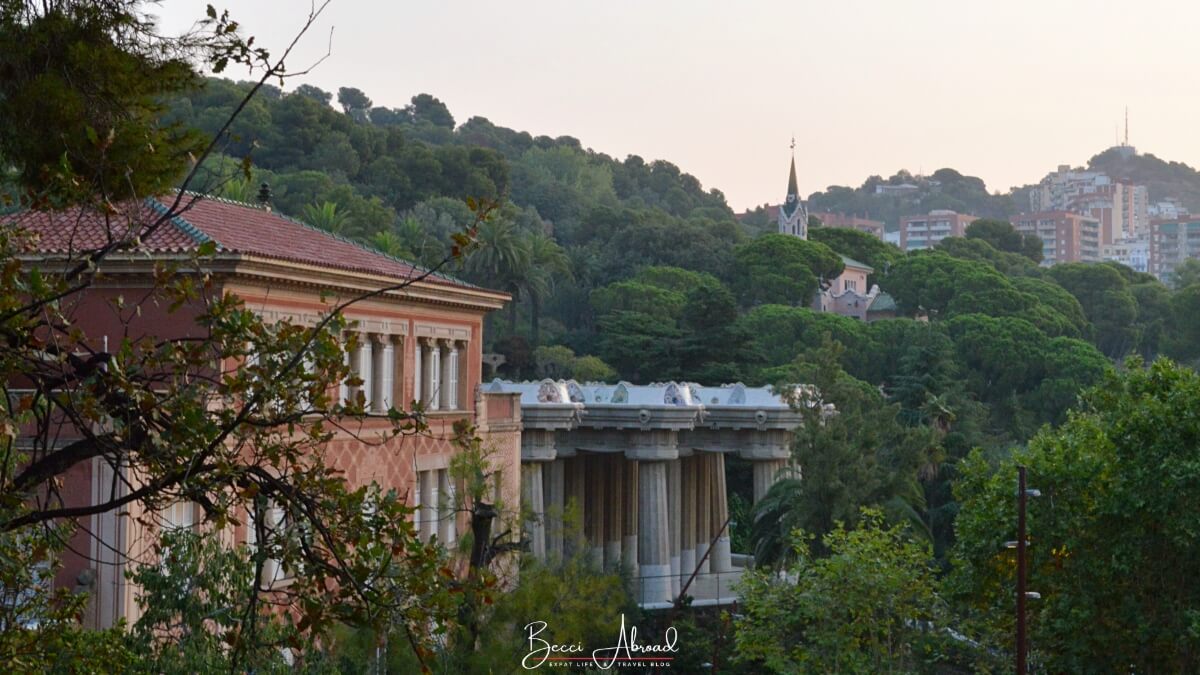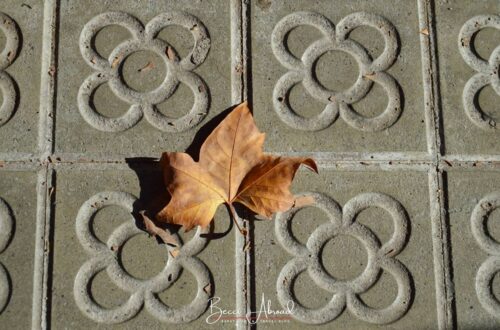Park Güell: The Complete Guide for First-Timers
Are you planning a visit to Park Güell during your trip to Barcelona?
Then you have come to the right place!
Park Güell is one of the biggest tourist attractions in Barcelona and is visited by millions of people every year.
However, planning your trip to this world-famous UNESCO World Heritage Site can also be a bit confusing at first! How to get there? What to visit? Where to buy the tickets? How long time do you need?
This guide is for everybody visiting Park Güell in Barcelona for the first time who still feels confused and overwhelmed about planning their visit!
I have visited Park Güell several times over the years, from when I first solo-traveled around Spain in 2012 to now, after moving to Barcelona in 2023.
I have compiled all the necessary information in one place to make it as easy as possible for you to plan your visit! To get the best out of your
To make the most of your stay in Barcelona, consider booking one of the many boutique hotels in Barcelona or budget-friendly hostels perfect for any traveler!
In this guide, I try to answer some of the most common questions for you to have a smooth, enjoyable visit to Park Güell in Barcelona.
Let’s explore Park Güell together!
The Ultimate Park Güell Guide For First-Timers
Disclosure: Some of the links below are affiliate links. This means that at no additional cost to you, Becci Abroad will earn a commission if you purchase through one of those links. This helps to pay the bills and the maintenance of the site.
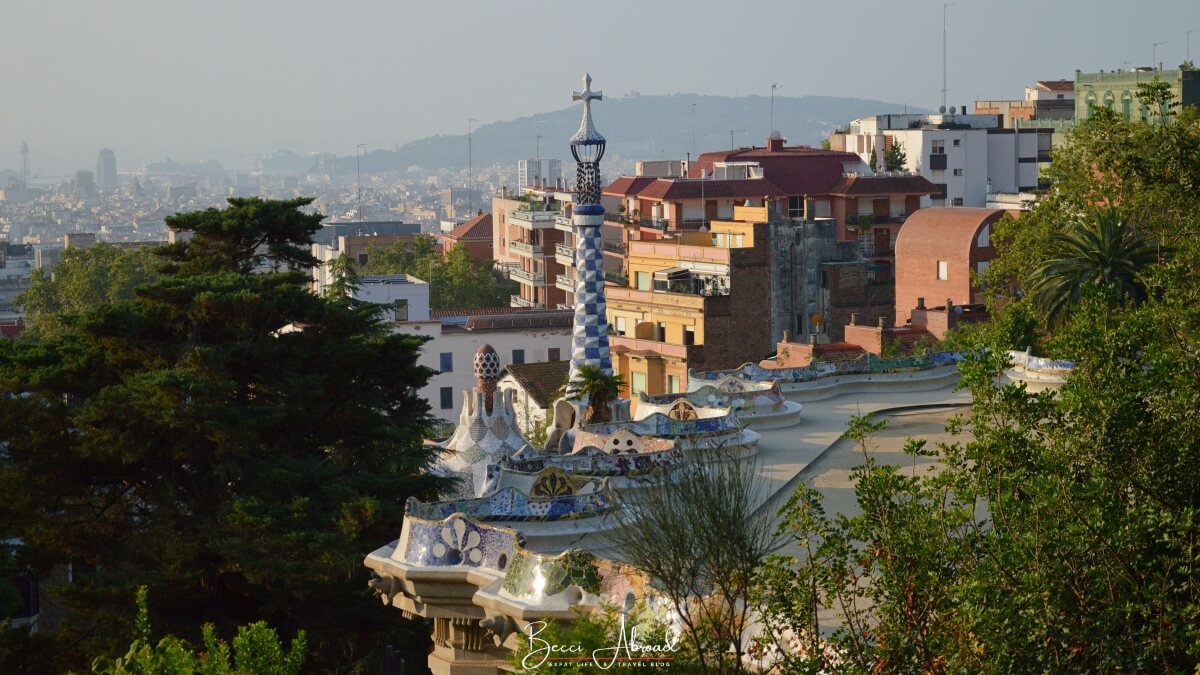
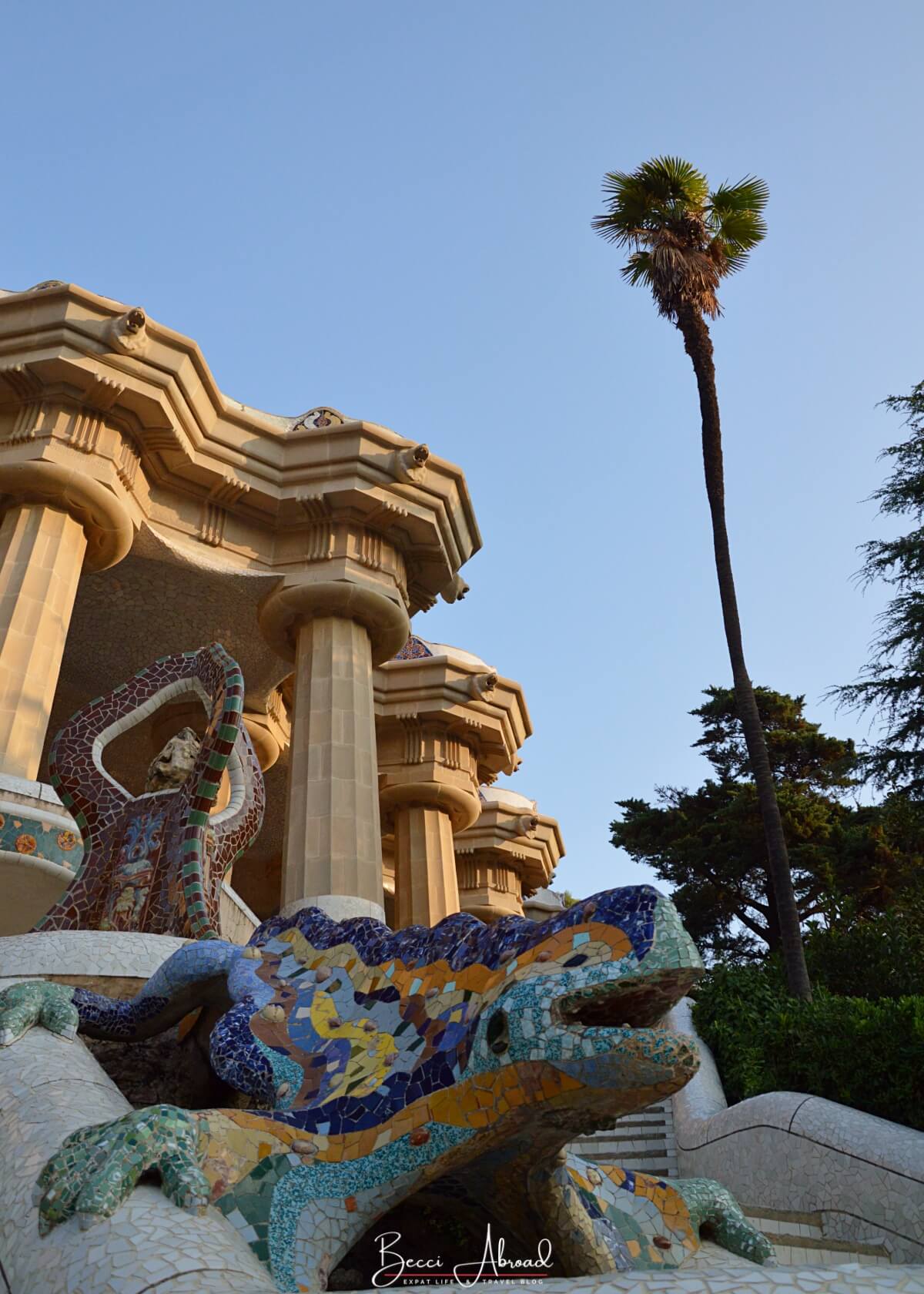

Getting to Know Park Güell
Before we get into the practical details of planning your visit, let’s explore a bit of the background of this iconic park in Barcelona!
What is Park Güell?
Park Güell is one of Barcelona’s most iconic landmarks! The park combines modernist architecture with local nature on a hillside in Barcelona.
Park Güell gets its name from Eusebi Güell, a wealthy industrialist who was the owner of the land and the patron of the architect who designed the park, Antoni Gaudí.
Originally, the park was intended to be a residential community. However, the project failed, and the original plans were never finalized.
Today, Park Güell is a public park. You can explore impressive architecture filled with colorful mosaics, mixed with pathways and a lush green forest-like park.
Who Designed Park Güell?
Park Güell was designed by the famous Catalan architect Antoni Gaudí.
Gaudí is also known for being the architect who designed Barcelona’s most famous tourist attraction, la Sagrada Família.
Gaudí was part of the Catalan modernist or Art Nouveau movement in the 1880s in Barcelona. He is known for his distinct style that blends nature with architecture.
In Art Nouveau, nature was brought into the architecture through the use of organic forms such as lines and curves mimicking the formations of trees, plants, and rocks.
If you visit Casa Battló and Sagrada Familia, you can experience similar organic forms and references to nature as those used in Park Güell.
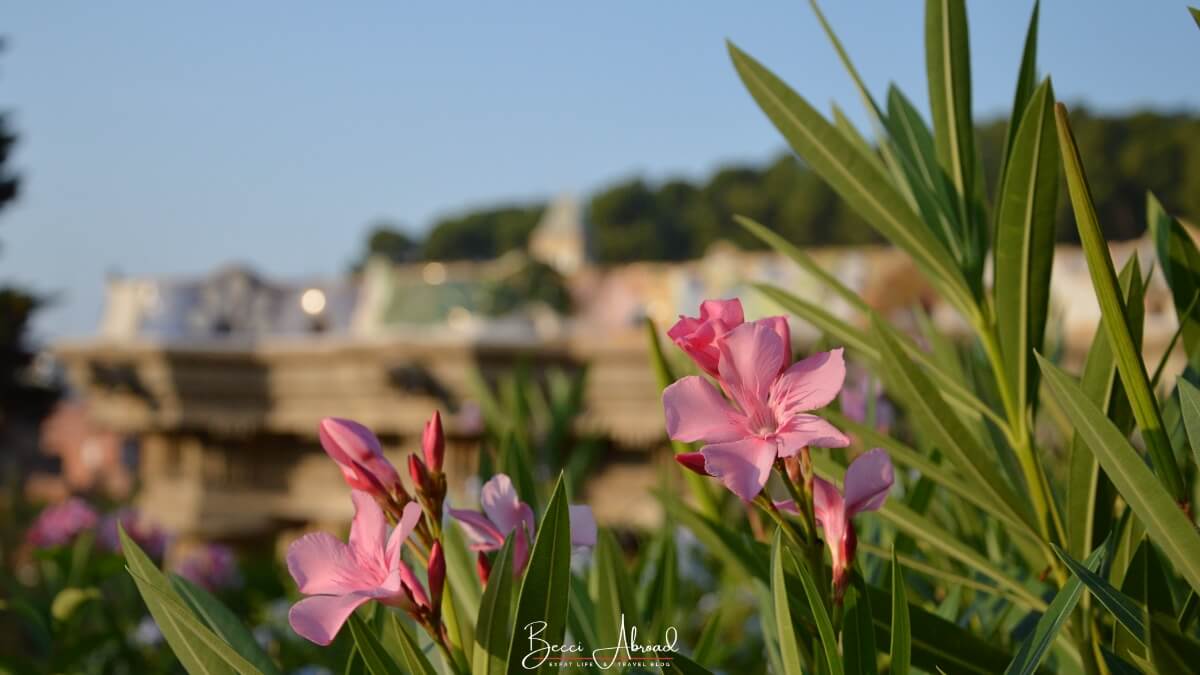
When Was Park Güell Built?
The construction of Park Güell began in 1900. The park was part of an ambitious residential project, commissioned by Gaudí’s patron, Eusebi Güell.
Eusebi Güell was a wealthy local Catalan businessman who wished to create a modern and luxurious housing area for the aristocracy in Barcelona. The location of the park would allow the elites of Barcelona to escape the noise and dirt of the industrial city that was Barcelona in the 19th century.
Güell himself was inspired by the English parks he had seen when visiting the UK and wished to create something similar in Barcelona.
However, the residential part of the project was never fully realized. The local elite in Barcelona found the price of the land too expensive and the access to the area too complicated.
In the early 20th century, the location of Park Güell was even more complicated to get to than it is today. The uphill roads to the park were of poor quality, and at the time, no metro or buses were going there.
Only three buildings were completed in the park: the house where Gaudí lived with his father and niece, now known as the Gaudí House Museum. Today, you can visit this house as it is a museum.
Casa Larrard by the entrance of the park, where Eusebi Güell himself lived since 1907. Today, this house is a local school located inside the park.
Finally, Casa Trias was constructed for and owned by a Catalan lawyer, Martí Trias i Domènech, who was a close friend of both Güell and Gaudí.
When Was Park Güell Finished?
The work on Park Güell continued until 1914, even though it became clear already in 1906 that the luxury residential park wasn’t achievable.
The construction of Park Güell stopped in 1914 with the outbreak of World War I.
The owner of the park and Gaudí’s patron, Eusebi Güel, lived in his house, Casa Larrard, inside Park Güell until he died in 1918.
In 1922, Güell’s family sold the land and his house to Barcelona’s City Council, with the condition that it would be opened to the public as a park.
Gaudí himself continued to live in his house in Park Güell until 1926, when he passed away. After Gaudí’s death, Park Güell was opened as a public park.
In 1984, Park Güell became part of the UNESCO World Heritage Sites as part of the “Works of Antoni Gaudí” Collection.
Ever since, the park has been an increasingly popular tourist attraction in Barcelona.
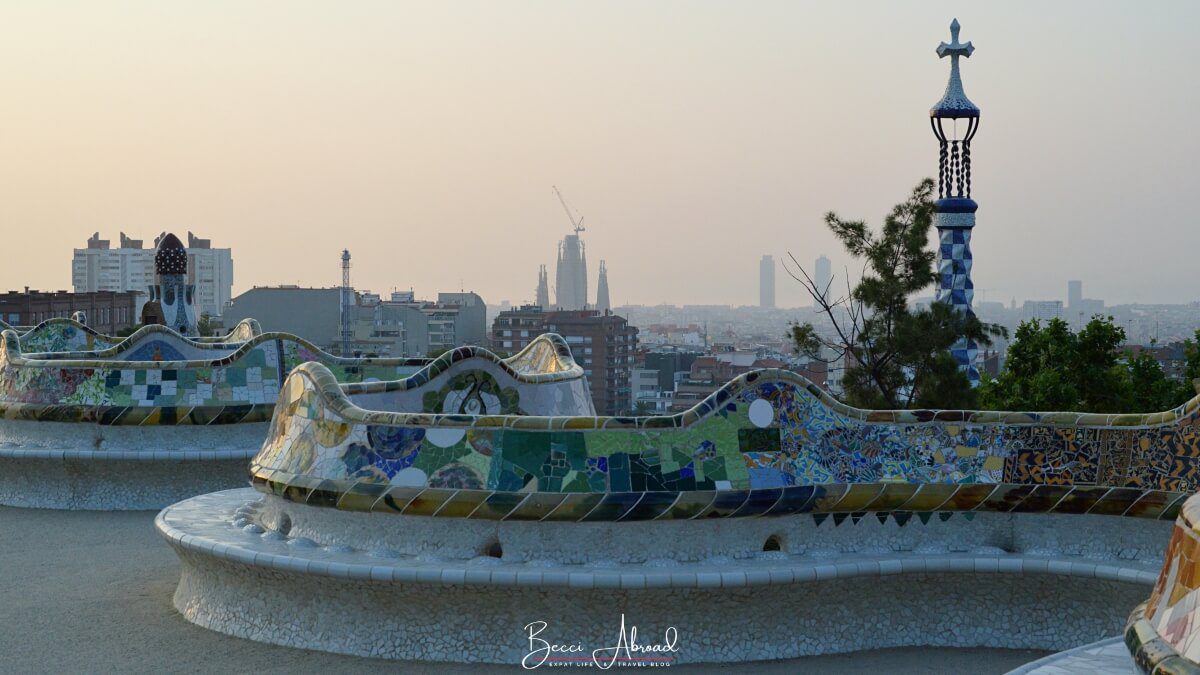

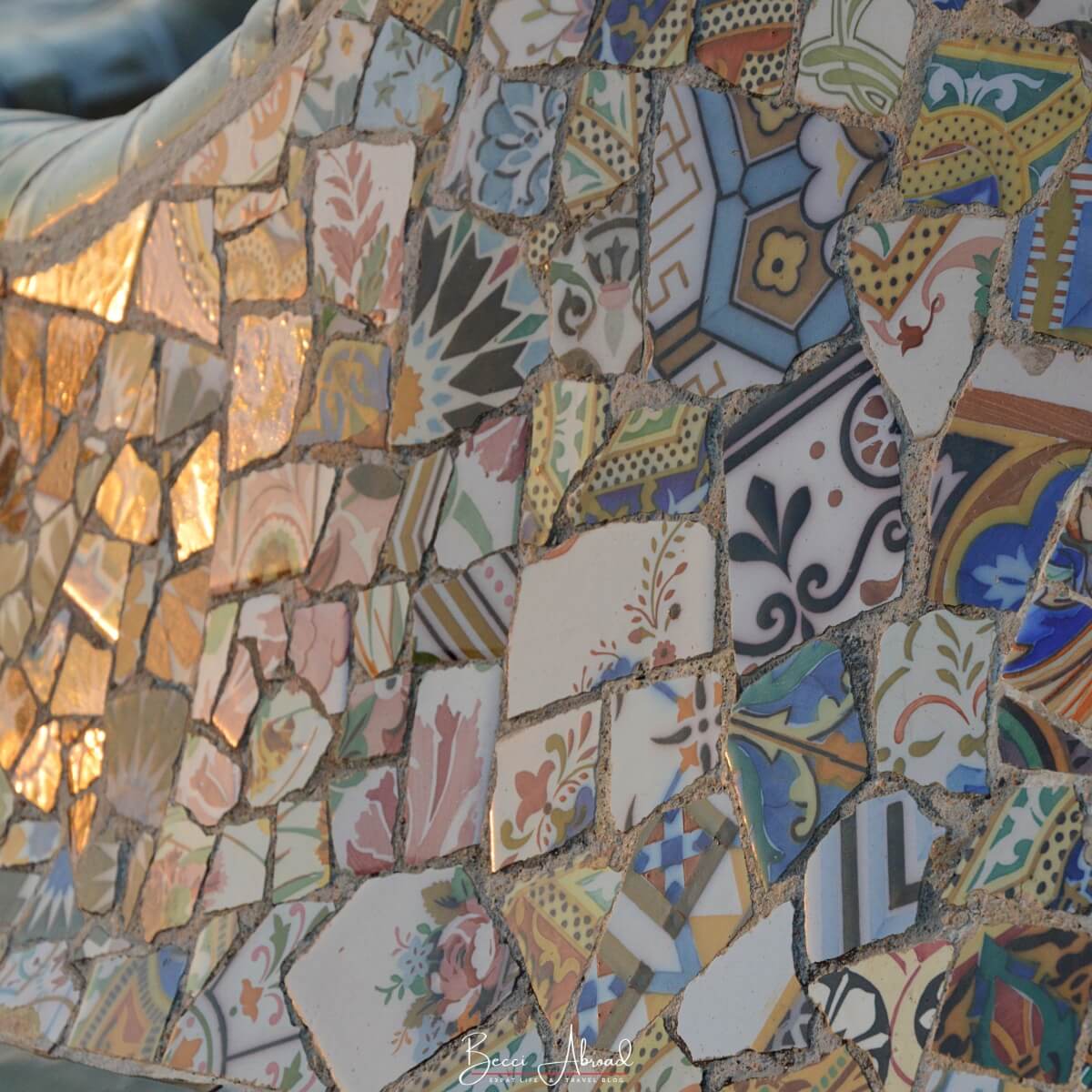
What Is Park Güell Famous For?
Park Güell is famous for featuring Gaudí’s unique architecture with curved, fantastic buildings and vibrant mosaics.
The most famous part of Park Güell (and the one you’ll have seen in most pictures) is called the Monumental Zone.
The Monumental Zone is the main part of the park and features an impressive staircase leading up to serpentine benches with beautiful, colorful mosaics and stunning panoramic views of Barcelona.
The modernist architecture that Gaudí represents is known for seeking to integrate nature and design in a seamless mix.
Where Is Park Güell Located?
Park Güell is located on the hillside of Carmel Hill in the Gràcia neighborhood in Barcelona.
The location of Park Güell on a hillside makes access and getting around in the park mostly uphill.
You could take this into account when planning your visit! You might need to set aside some extra time for water breaks when exploring these uphill parts of Barcelona
The Gràcia neighborhood is situated in the northern part of Barcelona but is easily reached by metro, bus, or taxi from the city center.
Park Güell on a Map
Click on “View larger map” to open the location in your Google Maps app or in a separate window.
Plan Your Trip to Park Güell in Barcelona
In this section, you will find practical information and the best tips for planning your trip to Park Güell in Barcelona!
What Is the Best Time to Visit Park Güell?
The best time to visit Park Güell is early in the morning!
Head to Park Güell around 9 am – 10 am in the morning when the park opens to get the best chance to explore the park without too many crowds.
In the summer months (June through August), the temperatures in Barcelona can also get quite high. So, I would strongly recommend visiting as early in the morning to avoid the Barcelona summer heat.
Alternatively, you can also aim for late afternoons, just before the park closes, when the sun isn’t as strong.
When you book your ticket, you need to choose a timeslot for your visit, and sometimes timeslots are sold out as people book their tickets well in advance.
The last time I visited was in August, in the very early morning before the park opened (there is a special offer for residents in Barcelona to visit before the normal opening hours). At 9 am, more and more people were entering the park, and as the sun came up, it started to heat up very quickly!
Park Güell Tickets
Getting your tickets for Park Güell is the most important thing you need to do when you plan your visit!
Tickets to Park Güell sell out quickly! There are limitations on how many people are allowed in per day. Especially during peak season in the summer, it might be almost impossible to get same-day tickets.
As of 2023, it is now mandatory to book your tickets to Park Güell in advance online!
The tickets to Park Güell are available online one month in advance for the day you wish to visit.
There used to be a part of Park Güell that you could visit free of charge, but that’s no longer the case. You need a ticket to enter all parts of the park now!
You can print your ticket and bring it along or save it on your smartphone – either option is accepted at the entrance!
Check the availability of tickets from GetYourGuide here:
Timeslots
Park Güell has fixed timeslots for when you can enter the park. So, when booking your tickets, you have to choose a time slot for your visit to Park Güell.
The time slots are 30 minutes long. During this time, you can enter the park with your ticket.
Once you have entered Park Güell, you can freely explore the different parts of the park.
However, you should keep in mind that you need to stick to this time slot. If you arrive outside your 30-minute timeslot, the guards at the entrances are likely to refuse you access, and there are no refunds on your ticket.
The last entrance is one hour before the park closes.


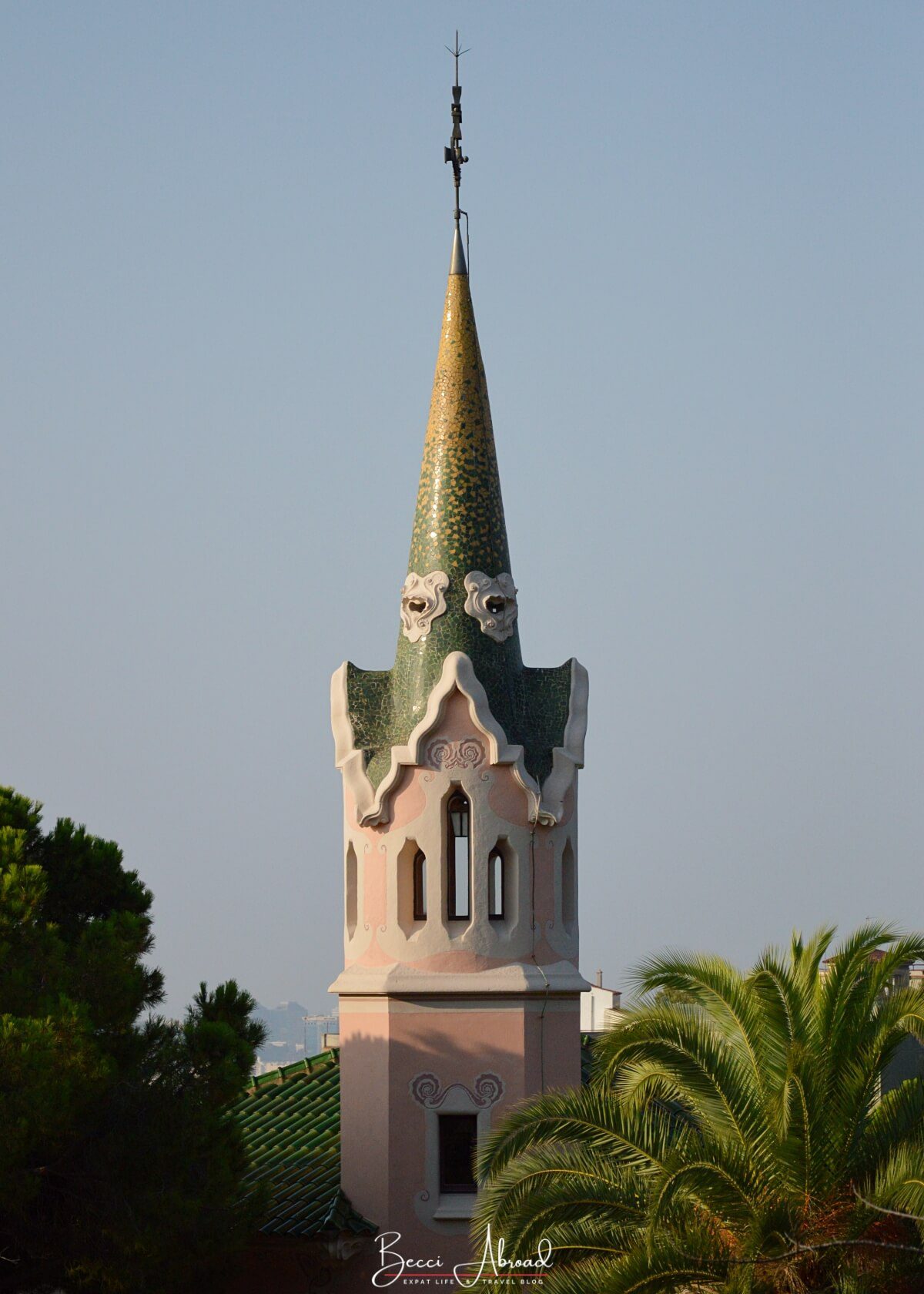
How Much is Park Güell Entrance?
General admission to Park Güell is between €10 – €14 for adults.
The general admission doesn’t include access to the Gaudí House Museum. You can purchase the tickets to the Gaudí House Museum at the entrance to the museum once inside the park.
There are also some discounts for children, seniors, or residents.
How to Buy Park Güell Tickets?
Tickets can be purchased online through the official Park Güell website or tour apps like GetYourGuide and Tiquets.
The Official Park Güell Website
You can purchase your ticket on the official website of Park Güell.
The official website doesn’t charge any administration fees. However, sometimes people report trouble paying with foreign credit cards on the site.
Also, sometimes the official website has some sort of bug, where if you try to change the language from Spanish to another language, it doesn’t accept the payment (a rocky mistake, honestly!).
So, if you are experiencing issues with the official site, try keeping it in Spanish or simply book on an international app.
The official website has the most up-to-date information on opening hours and available tours, so it is a good site to bookmark and check before you go.
Park Güell Skip the Line Tickets
GetYourGuide and Tiqets offer skip-the-line tickets to Park Güell on their app and website.
Honestly, it isn’t really a skip-the-line ticket as you just show it at the entrance like everybody else who bought their tickets online.
The benefit of the GetYourGuide ticket to Park Güell is that you can have all your entrance tickets in one place for the attractions and activities you are doing in Barcelona!
Another benefit of using GetYourGuide to get your tickets is that you shouldn’t have any issues with using your credit cards. And you can keep the whole process in English (or any other language of your choice!)
Check availability for tickets from GetYourGuide here:
Barcelona City Pass
The entrance to Park Güell is included in the Barcelona Pass.
The Barcelona Pass includes entrances to several other famous attractions around the city, as well as Sagrada Família and the Hop-on Hop-off bus tour.
Check the pricing for the Barcelona Pass on Tiqets.
Should You Book Your Ticket in Advance to Park Güell?
Yes, you should definitely get your tickets to Park Güell in advance!
As I mentioned above, from last year (2023), it became mandatory to book your tickets to Park Güell in advance online!
The park has even had big ads on billboards in the metro to remind people to book online before going.
So yes, yes, yes, book your tickets in advance!
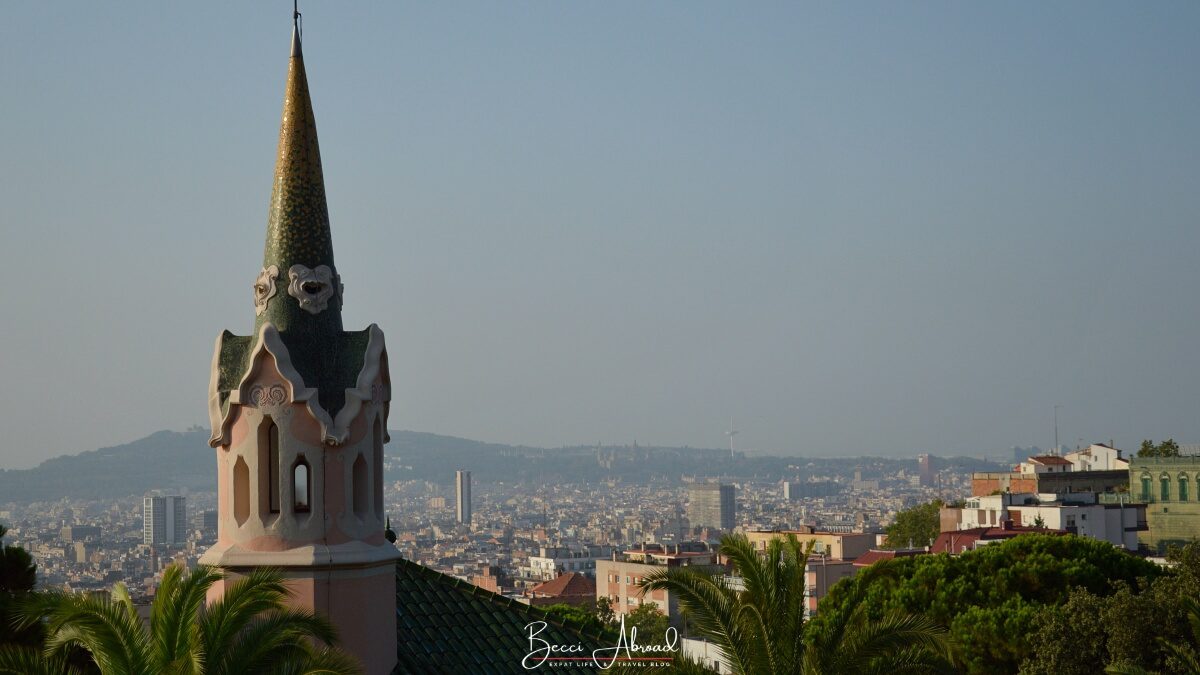
Park Güell Opening Hours
Park Güell is open every day, all year round.
The opening hours of Park Güell vary slightly based on the season:
- From 1 July to 31 August: 9 am to 7:30 pm
- From 1 September to 29 October: 9:30 am to 7:30 pm
- From 30 October to 31 December: 9:30 am to 5:30 pm
Always double-check the official Park Guell website for any changes in opening hours.
Access and Opening Hours for Residents
If you are a resident of Barcelona, you can visit Park Güell at no cost any time between 7 am and 10 pm.
To take advantage of this offer, you need to register with the Gaudir Més program from the Barcelona City Council.
You don’t need to buy a regular entrance ticket. Instead, you request your entrance to Park Güell on this page for the Gaudir Més website on the same day you wish to visit. You will receive an email with a special entrance ticket to the email address you used for registering for Gaudir Més. Show the ticket on your smartphone at the entrance.
Residents of Barcelona registered for Gaudir Més also have exclusive access to Park Güell every day between 7 am to 9 am and from 6 pm to 10 pm. Tourists are not allowed during these hours, and locals use the park as any other public park for running or walking their dogs.
What to Wear to Park Güell?
Comfortable shoes are essential when visiting Park Güell!
I would also recommend somewhat comfortable clothes and dressing in layers, so you can easily change if the weather conditions change or the uphill walking gets too much.
Visiting Park Güell also involves a lot of walking, both to get to the entrance (if you don’t take a taxi directly to the entrance) as well as inside the park.
Apart from the area around the main entrance and the Monumental Zone, where the stairs are nicely done, there are many uneven paths and inclines through the park.
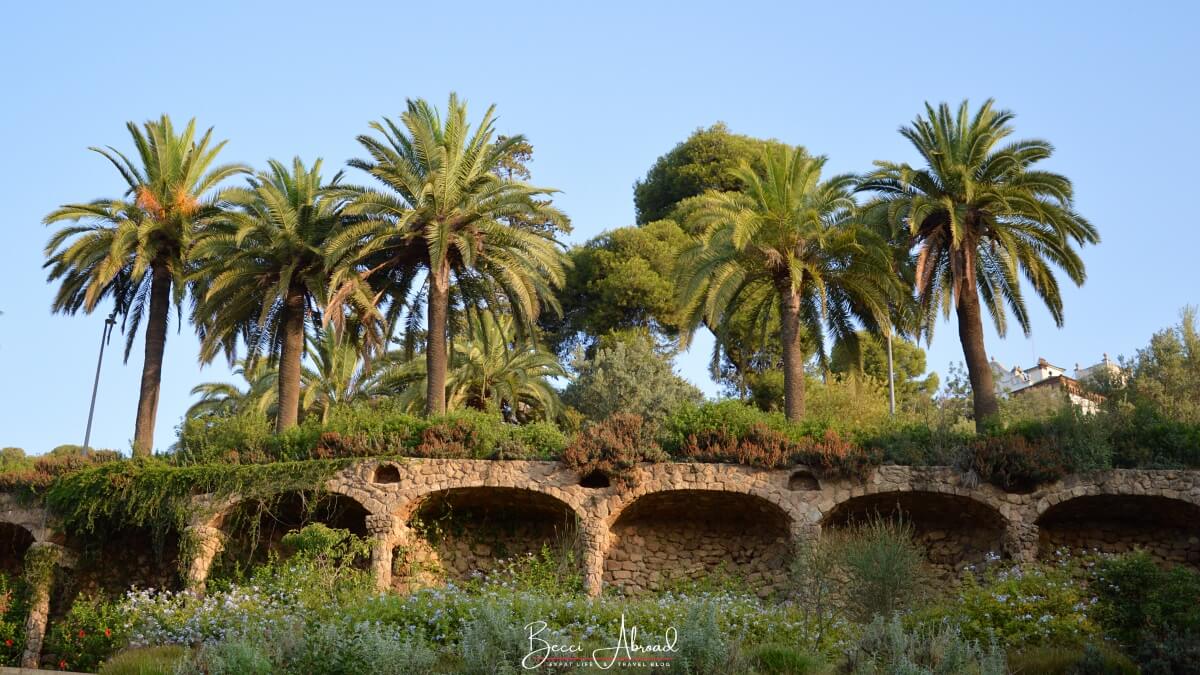
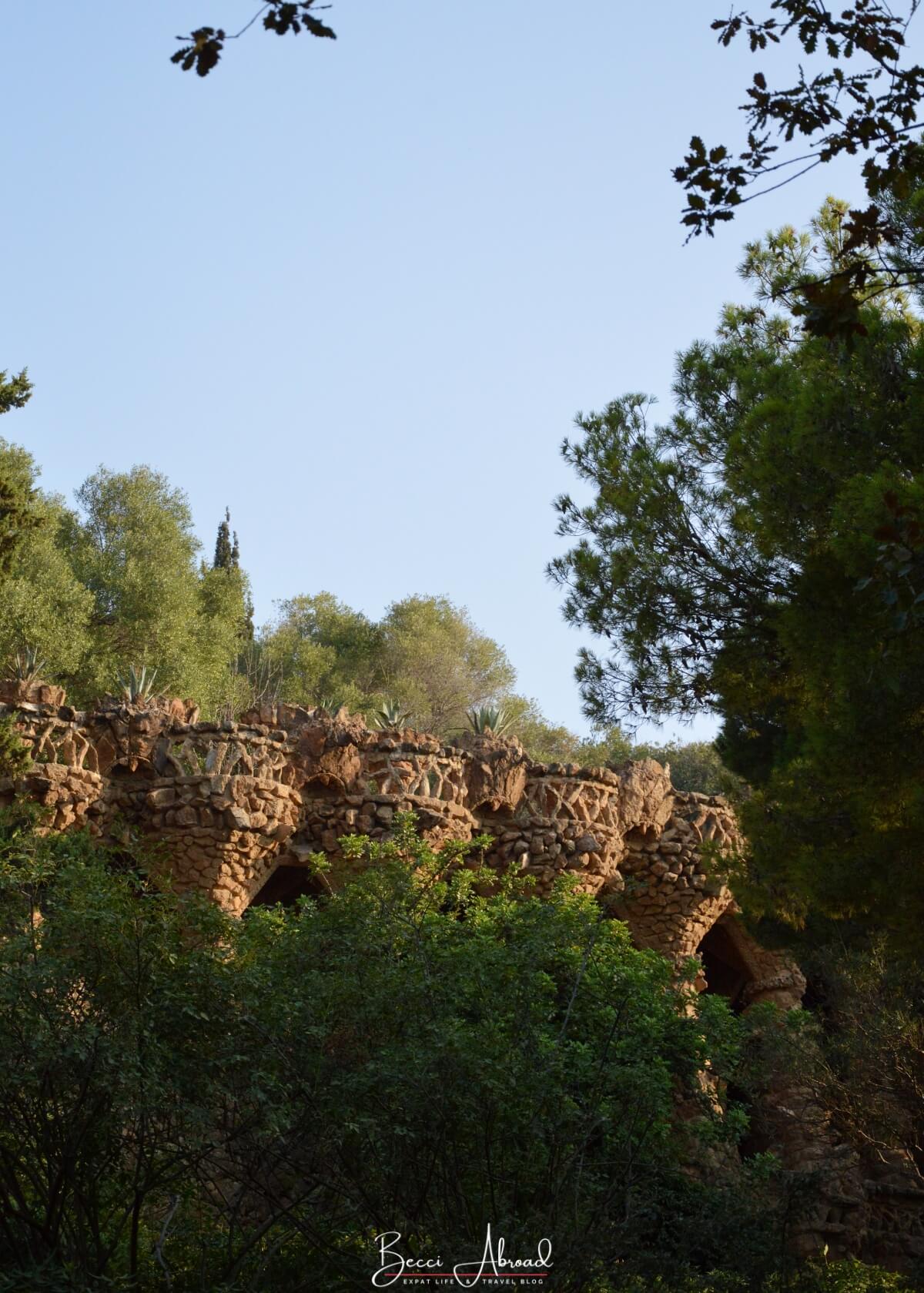

Where Is the Entrance to Park Güell?
There are several entrances to Park Güell, the most popular being the main entrance on Carrer de Larrard and Carrer d’Olot.
The Main Entrance – Carrer de Larrard/Carrer d’Olot
The main entrance is located at the intersection of Carrer de Larrard and Carrer d’Olot.
This entrance is the most popular entrance to Park Güell, and it leads directly to the Monumental Zone, where visitors can explore Gaudí’s most famous structures.
The Upper Entrance – Avenida del Santuari de Sant Josep de la Muntanya
The upper entrance is located in the highest part of Park Güell. This entrance is usually less crowded, but it can also be a bit of an adventure to get up there.
If you get off the metro at Vallcarca metro station, the directions and signs will lead you to the upper entrances. The roads to get to the upper entrance are very much uphill.
The Carmel Entrance – Carretera del Carmel
The Carmel entrance is located on the road, Carretera del Carmel, on the opposite side of the park from the main entrance.
You can take the blue L5 metro line to the metro station El Carmel, and walk from the station to the Carmel Entrance. It is around a 20-minute walk from the metro station.
The Carmel entrance is primarily used for big groups and group tour buses. If you are not arriving with a large group, I would recommend that you don’t use the Carmel entrance.
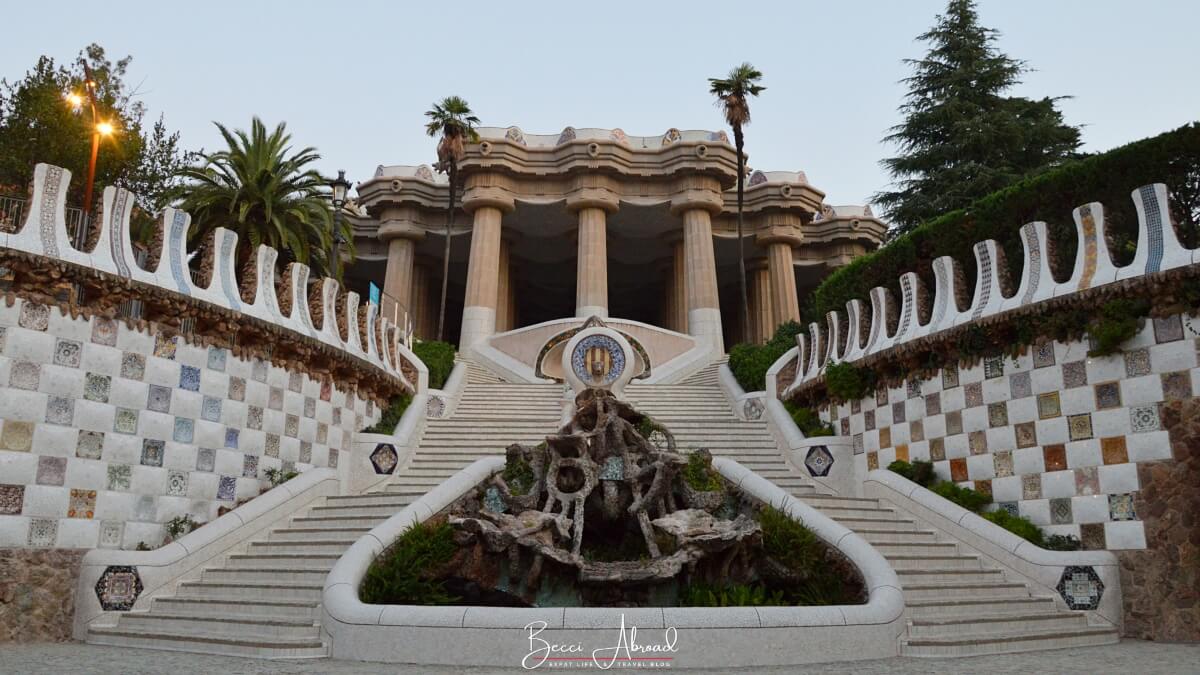
How Long to Spend at Park Güell?
How long you need to visit Park Güell depends on how much of the park you want to see and how much walking you want to do.
If you want a more in-depth experience of the park, it typically takes 1.5 to 2 hours to explore the Monumental Zone and enjoy the surrounding paths and trails around the park.
And if you are a wannabe photo-geek and explorer-type like myself, you can also easily end up spending closer to 3 hours at Park Güell.
However, if you want to explore the main parts around the entrances and the Monumental Zone, you can do it properly in 30 minutes to 1 hour.
How Big Is Park Güell?
Park Güell spans over 17 hectares of land on the hillside of Carmel Hill. Most visitors focus on visiting the 12-hectare Monumental Zone.
Can You Visit Park Güell on Your Own?
Yes, you can definitely visit Park Güell on your own!
Personally, I have visited the park several times alone, and it is completely safe to visit on your own. There are also plenty of maps and signage to help you navigate the park.
Since the park is so big, as soon as you get away from the most popular areas around the Dragon Stairway and the Monumental Zone, the park is not too crowded.
To explore the park more in-depth and learn more about why the park is so famous, you can also sign up for a guided tour.
Book your guided tour here
What to Do in Park Güell?
Park Güell is made up of several parts and has interesting places to visit.
Let’s explore the best things to do in Park Güell!
The Entrance & Porter’s Lodge Pavilion
As you enter Park Güell, you’ll be greeted by two whimsical gingerbread houses on either side of the main gate, known as the Porter’s Lodge Pavilions.
The Porter’s Lodge Pavilions feature colorful ceramic mosaics and curved roofs and have become an iconic landmark of Barcelona. The buildings were originally meant to serve as a porter’s office and a waiting room for visitors.
You can freely enter both houses as part of your ticket. However, sometimes there is quite a long queue outside either house. Inside one of the buildings, you will find a small souvenir shop.

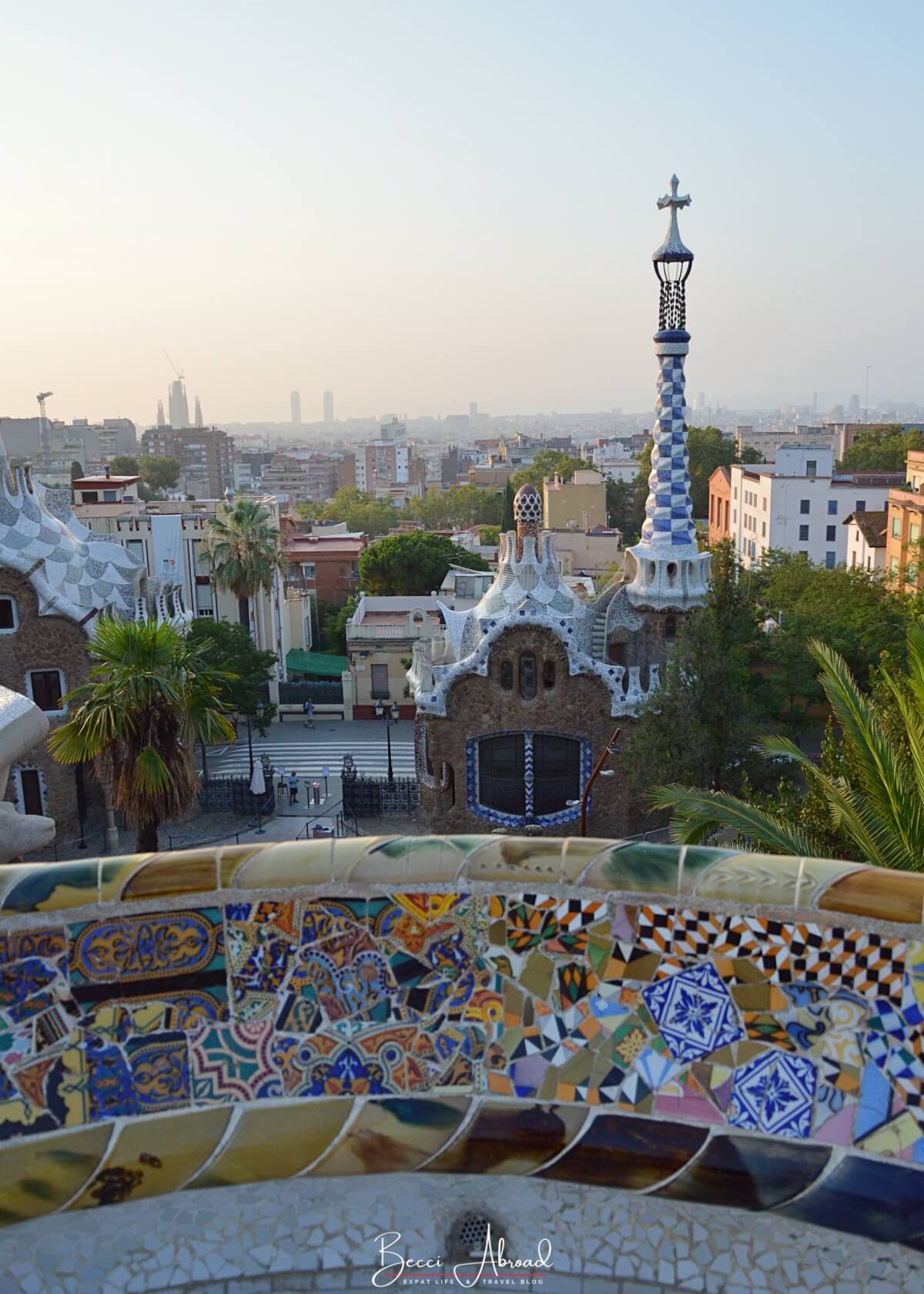
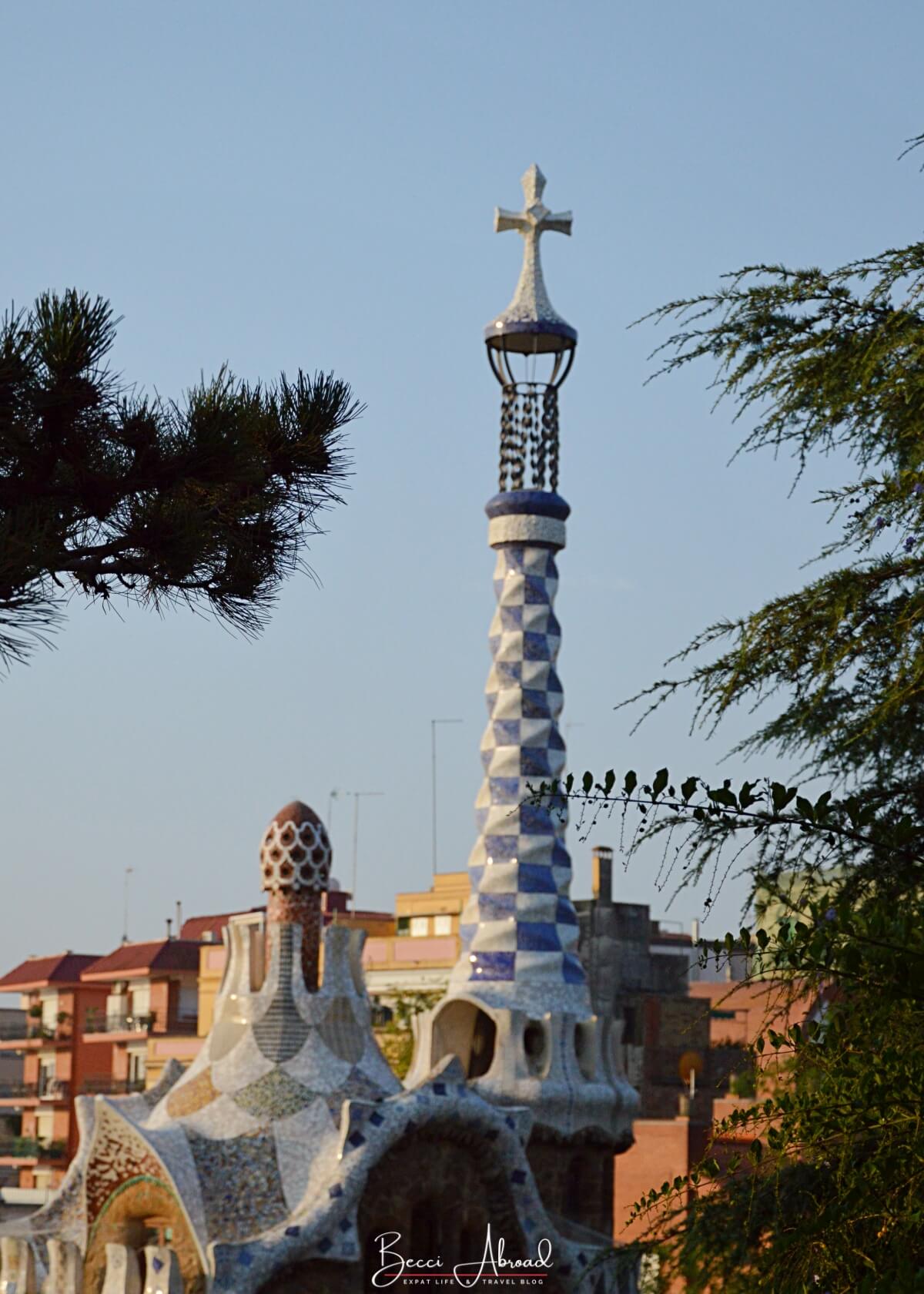

The Monumental Zone
The Monumental Zone is the most iconic part of Park Güell and is the part that most visitors come to see.
The Monumental Zone is the part of the park that is a UNESCO World Heritage site, and it houses some of the most popular things to do in Park Güell, such as the Dragon Stairway, the Hypostyle Hall, and the Serpentine Bench.
You can visit the Monumental Zone as part of your general admission ticket to Park Güell.
In 2013, the Barcelona City Council put limits on the number of visitors who can visit the Monumental Zone to help protect the area. Today, a maximum of 1,400 visitors is allowed per hour. That’s why you have to book a time slot on your ticket and respect the assigned time slot. Once inside the park, you can explore the park as you wish.
As you walk through, you’ll find numerous spots to stop and admire the impressive designs and stunning views over the city.
Let’s explore what to visit in the Monumental Zone in Park Güell:
El Drac & the Dragon Stairway
The Dragon Stairway is one of the most famous landmarks in Park Güell. In the middle of the stairway, you will find Barcelona’s most famous mascot, “El Drac”.
El Drac, which means the Dragon in Catalan, is a colorful mosaic-covered salamander or lizard sculpture that guards the stairway. You will most likely have seen pictures or souvenirs of El Drac around Barcelona.
The Dragon Stairway leads from the main entrances to the Hypostyle Hall. The stairway is divided into three sections: The lower section features water flowing through the dragon. The middle and upper sections of the stairway are flanked by plant-filled basins.
The lizard sculpture is decorated using broken asymmetrically laid mosaic tiles, known as trencadís in Catalan. This technique is used in several other places throughout the park.
El Drac was made by Gaudí in collaboration with Joseph Maria Jujol, another Catalan architect of the time.
The dragon is often used as an icon of Barcelona and is linked to the legend of the patron saint of Catalonia, Saint George. In Catalan, Saint George is known as Sant Jordi. If you happen to visit Barcelona in April, you might experience the city covered in roses in preparation for the festival of Sant Jordi, an important public holiday in Catalonia.



The Hypostyle Hall
The Hypostyle Hall is composed of 86 massive Doric-style columns that support the Nature Square above.
In Catalan, the hall is known as Sala Hipóstila, and its construction was completed in 1907. The columns are arranged to create a forest-like atmosphere, with the natural light filtering through the spaces in between the columns.
If you visit Sagrada Familia and listen to the audio guide or do a guided tour, you will recognize these references to threes in Gaudí’s architecture. This is Gaudí’s way of merging architecture with nature.
The columns are hollow inside and also work as a filtering system for the park. The water from the Nature Square above filters through the earth of the square into the columns and gets transported to a 12,000-liter cistern hidden underground beneath the floor of the Hypostyle Hall. The water system was meant to be integrated into the fountains and irrigation for the park.
The ceiling of the Hypostyle Hall features impressive circular mosaics adorning the vaulted roof. The adorning is another example of the work of Catalan architect, Josep María Jujol, who also assisted Gaudí in creating the famous lizard on the stairways.
The different colors of the adornments in the Hypostyle Hall represent the seasons of the year and the changes in the lunar phases.
The Greek town of Delphi inspired the Hypostyle Hall and was originally designed to function as a marketplace for the residents of the planned house development.
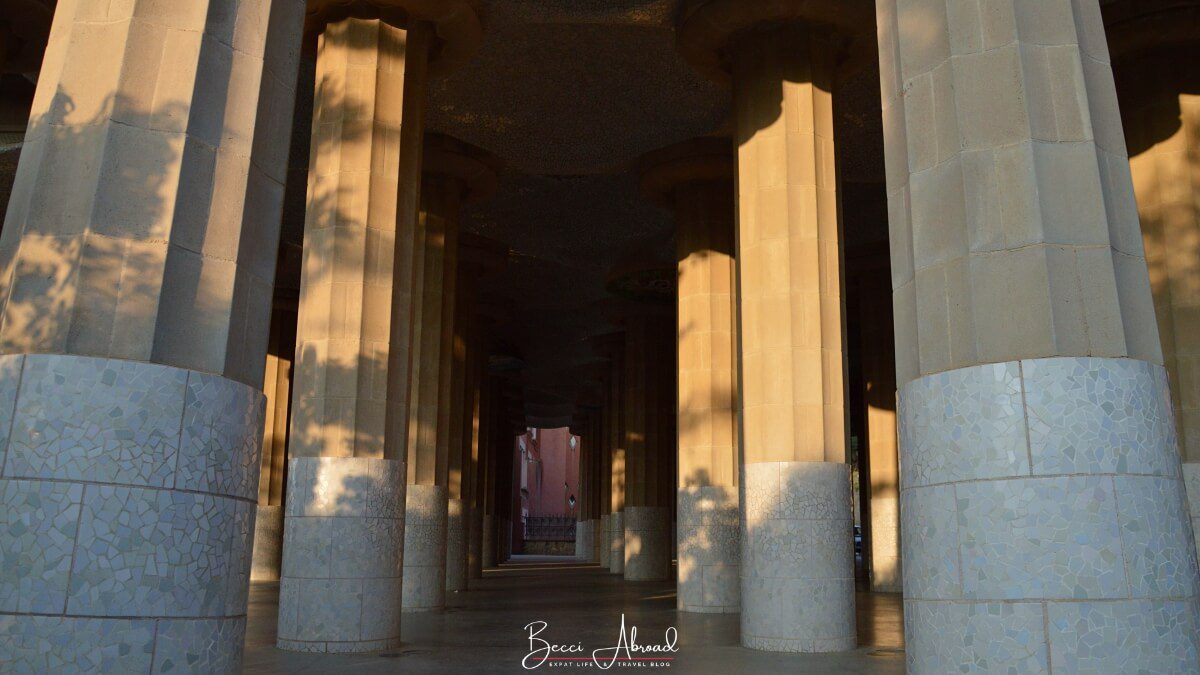

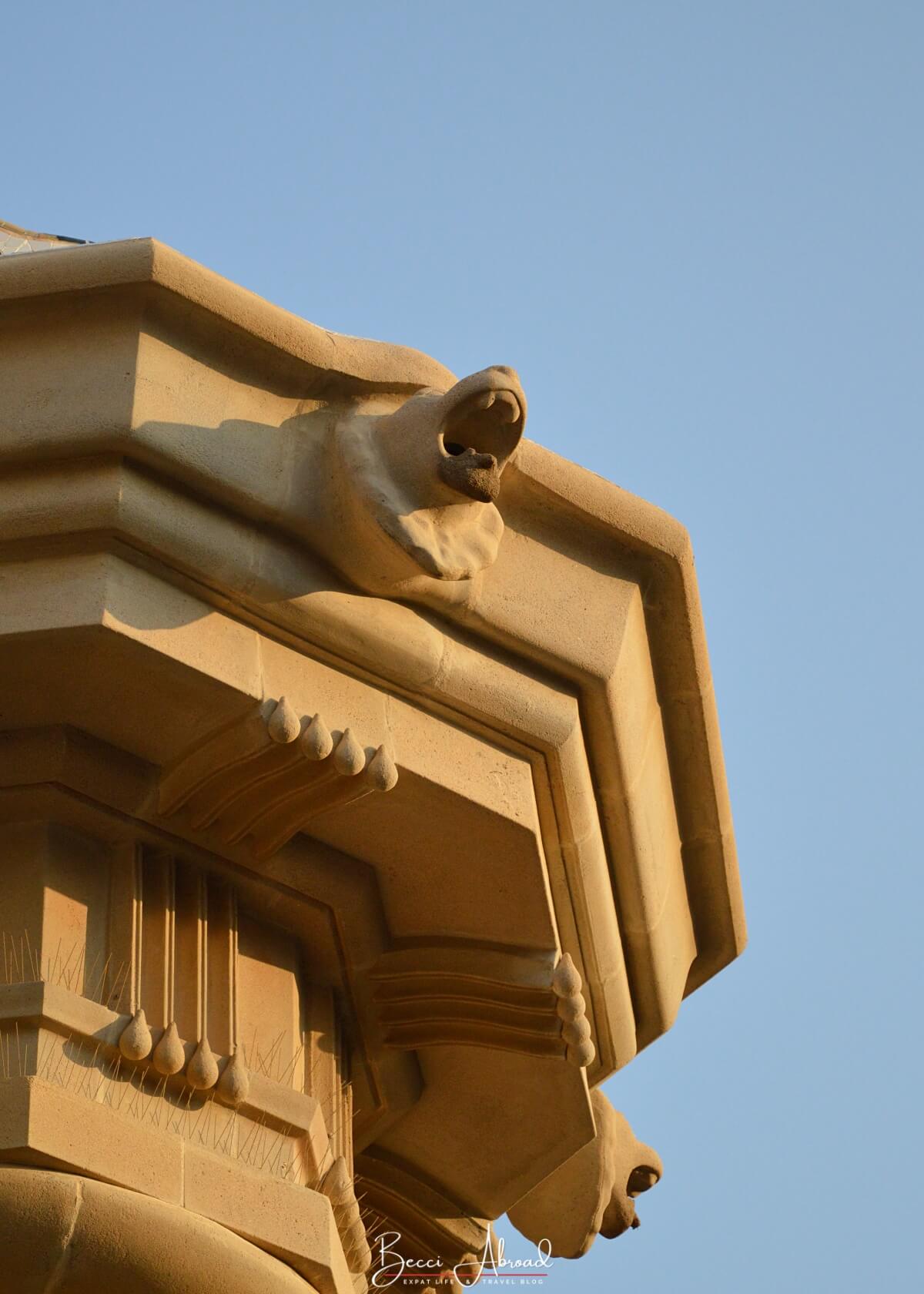
The Square and the Serpentine Bench
The Square and its wavy serpentine bench are properly the most famous and photographed place in Park Güell!
The Square, also known as Plaça de la Natura or translated as the Nature Square, is a large open-air terrace located above the Hypostyle Hall. The Square was originally called the Greek Theatre, and in many places, you’ll also find it referred to as such.
The edges of the square feature Gaudí’s famous serpentine mosaic bench. Gaudí’s inspiration for the bench is said to have been a sea serpent.
The long continuous benches stretch along the edges of the square and are decorated with the iconic colorful trencadís-technique of broken-tile mosaic.
The curious shape of the benches was meant to improve social interaction and bring people together.
On the outside of the balcony, you can see a line of lion heads decorated with mosaics. The lion heads act as part of the drainage system for the balcony.
The mosaic bench is a Gaudí masterpiece, allowing us to sit down and enjoy the scenery, both overlooking Barcelona’s skyline and the lush green nature of the park.
The square offers one of the best spots in the park to take in panoramic views of Barcelona, including the iconic Sagrada Família in the distance.
Embrace yourself in Gaudí’s world and learn how to master his trencadís-technique
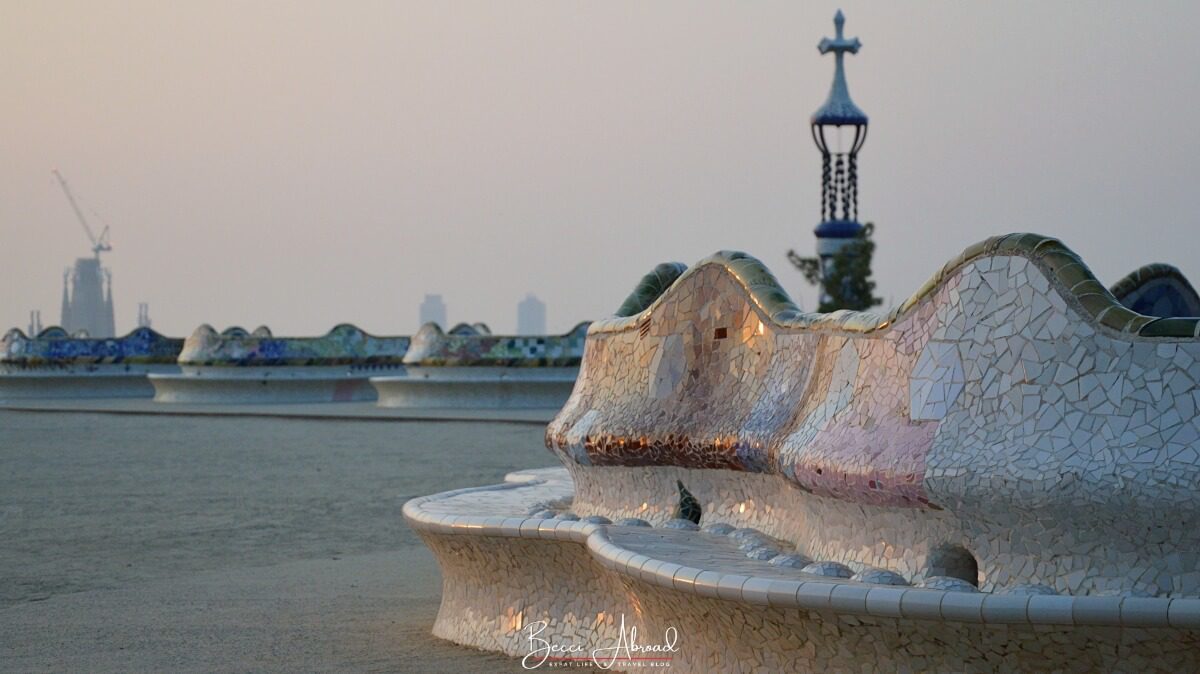
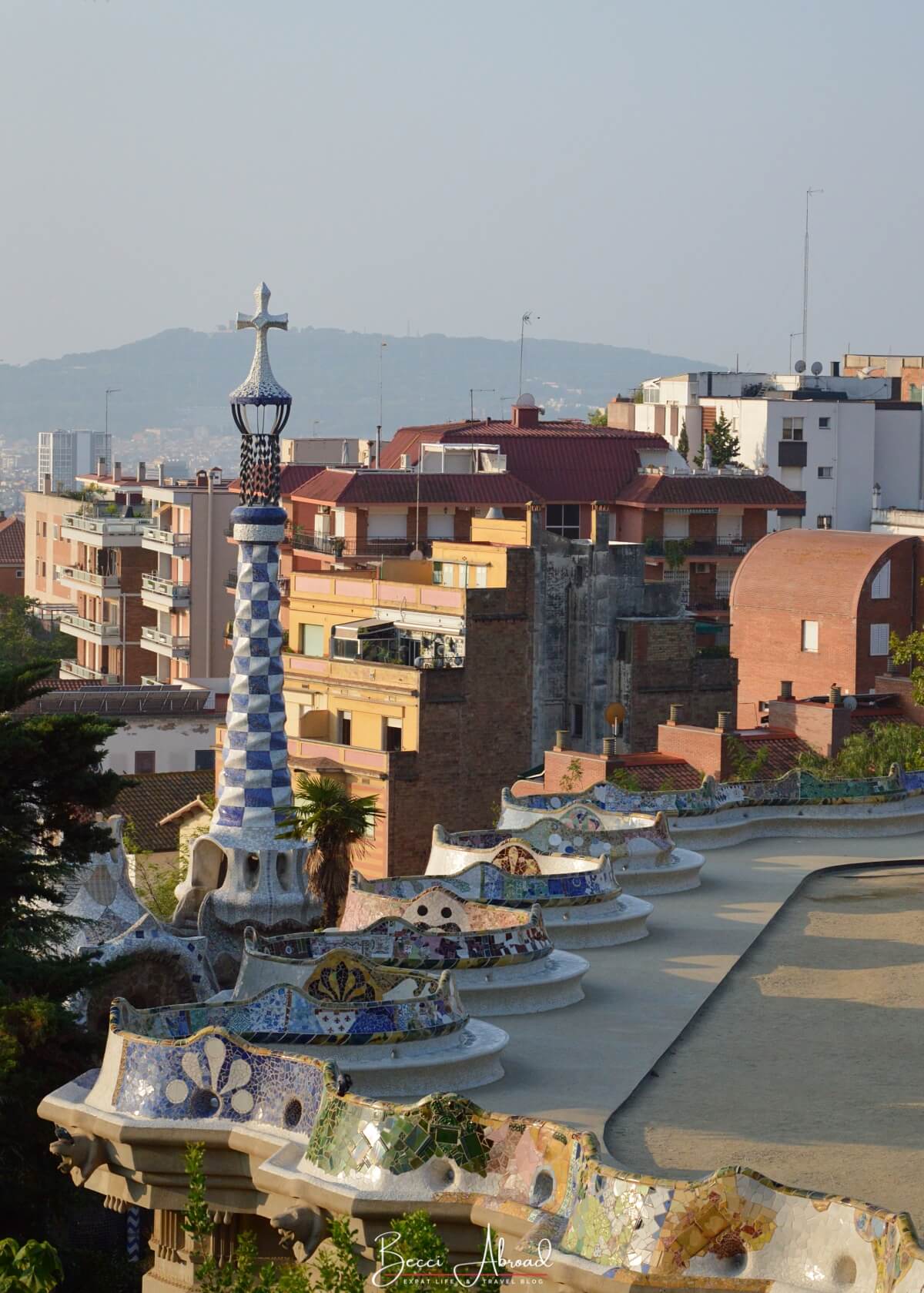

Admire the Views of Barcelona
The square and the serpentine benches are not the only places in Park Güell to admire the amazing views of Barcelona.
Since Park Güell is located on the hillside of Carmel Hill, throughout the park, you can enjoy some of the most stunning views of Barcelona!
Head up hidden pathways or small stairways to explore more of the park, and its various points to look out over the city’s skyline. From the park, you can see landmarks like the Sagrada Família, Torre Glories, and the Mediterranean Sea in the distance.

The Austria Gardens
The Austria Gardens is a quieter, more peaceful, and less crowded section of Park Güell, located right next to the famous Dragon Stairway.
Jardins d’Àustria, as the garden is called in Catalan, features a variety of native Mediterranean plants and trees. The gardens are dotted with sculptures and seating areas, making them a perfect spot to take a break during your visit.
The area was meant to have housed more residents of the ambitious housing project that Park Güell originally should have been. However, when the project failed, the area became a plant nursery.
The name of the garden comes from the fact that many of the trees were donated by Austria in 1977.


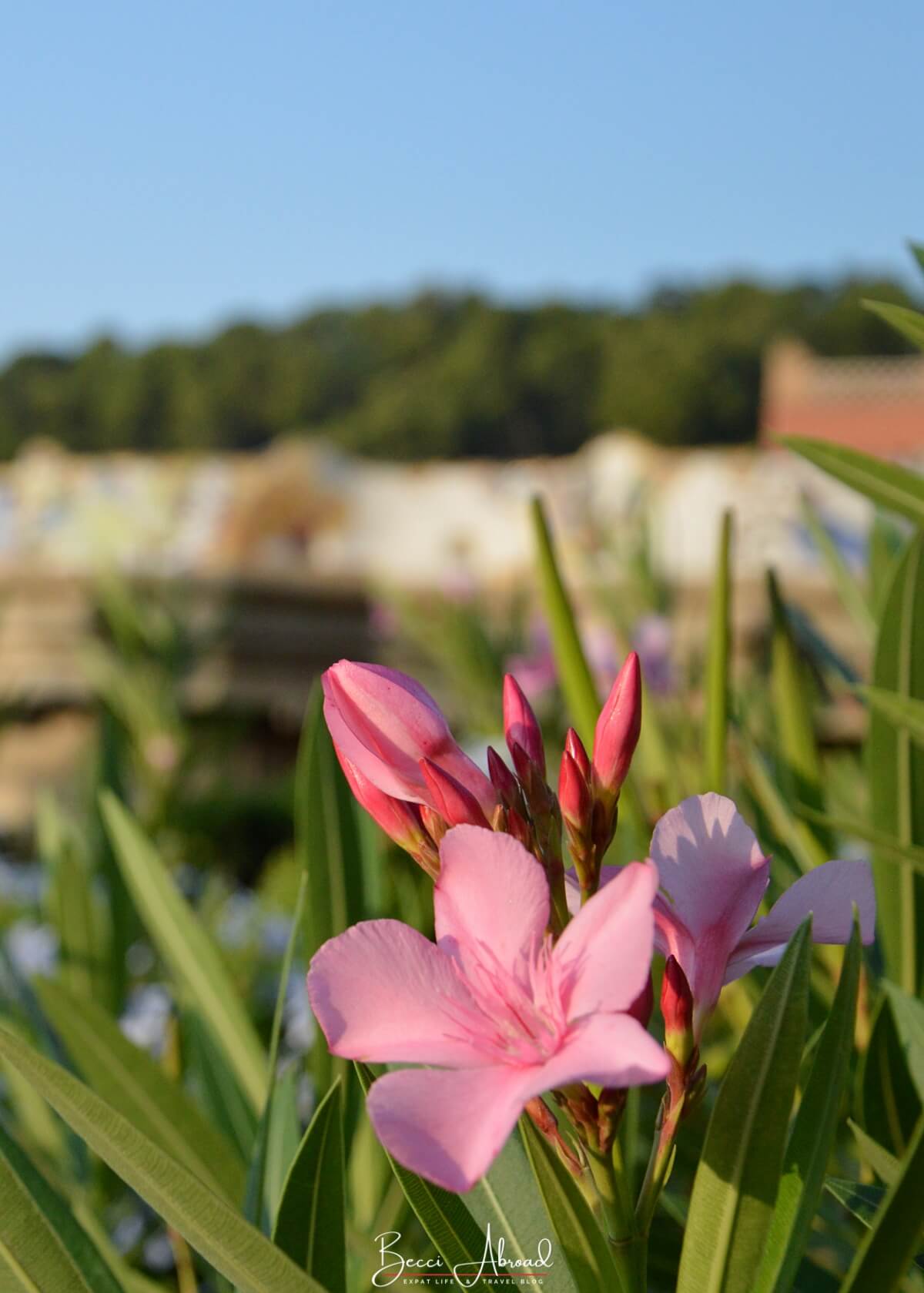
The Three Cross Hill
Three Cross Hill, also known as El Turó de les Tres Creus in Catalan, is one of the highest points in Park Güell. The hilltop features three stone crosses at its summit.
Originally, this location was meant to house a chapel, but during the construction, the workers found prehistoric remains. The construction of the chapel was stopped, and Gaudí opted for a simpler yet symbolic design.
Climbing to the top of the hill offers a bit of a challenge, and honestly, I didn’t find it worth the climb.
In the summer, the high trees below cover most of the view, and the access to the platform with the three crosses was closed.
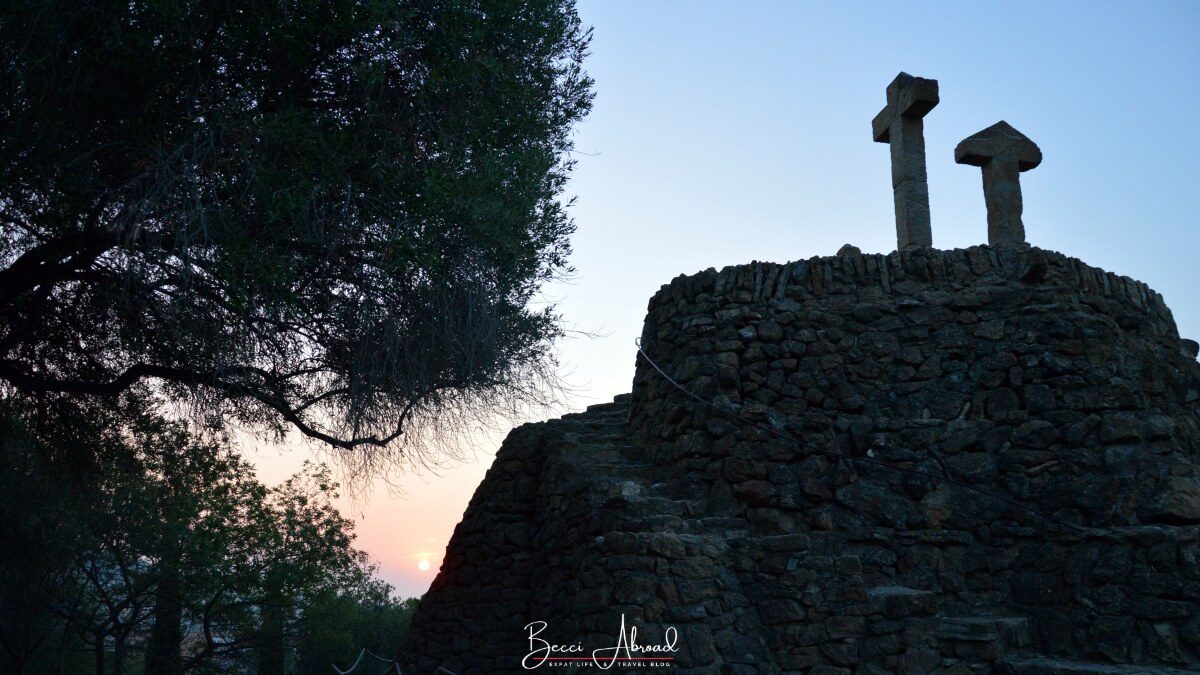
The Gaudí House Museum
Within Park Güell, you’ll find the Gaudí House Museum. The building’s pink walls with organic shapes and a spiking tower are hard to overlook when you start to explore the park.
Gaudí himself lived in the house from 1906 to 1926. The house is one of the few homes built when the residential project was still on the table as a part of the park’s future.
The house wasn’t designed by Gaudí but rather by another Catalan architect, Francesc Berenguer.
Nowadays, it is a museum showcasing a collection of furniture and objects designed by Gaudí, offering a glimpse into his personal life and creative process.

Forest Zone
The Forest Zone of Park Güell is an expansive area covered with trees and walking paths. It’s a more natural and less developed part of the park, where you can enjoy a peaceful stroll through shaded, wooded areas.
The Forest Zone contrasts with the more architectural sections of the park and offers a closer connection to nature and the local flora and fauna in the park
The Forest Zone is slightly more uphill than the Monumental Zone, making it an area that fewer people end up exploring.
If you have the time (and energy), I will definitely recommend that you give it a try to see another part of Park Güell than the crowds.
Pathways and Viaducts
Throughout Park Güell, you will find several unique pathways and viaducts that Gaudí designed to integrate seamlessly with the surrounding landscape.
The viaducts are supported by slanted stone columns that mimic the shape of tree trunks, making them appear as though they are naturally growing out of the earth.
The viaducts serve both an aesthetic and a functional purpose as they allow you to explore the park without disturbing the hillside’s nature.
The viaducts can be found in different places around the park, and each of them has a different name, such as Pont de Baix and Pont de Dalt.
As you walk along these paths, you’ll feel as if you’re wandering through a fantastical woodland setting.
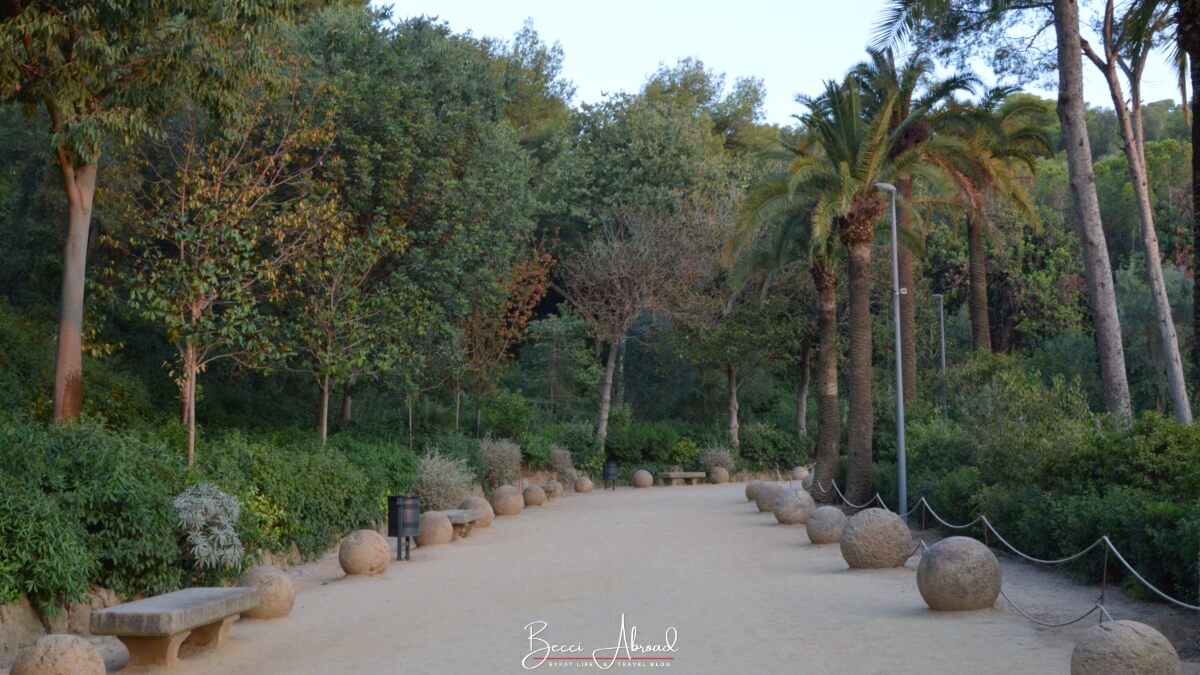
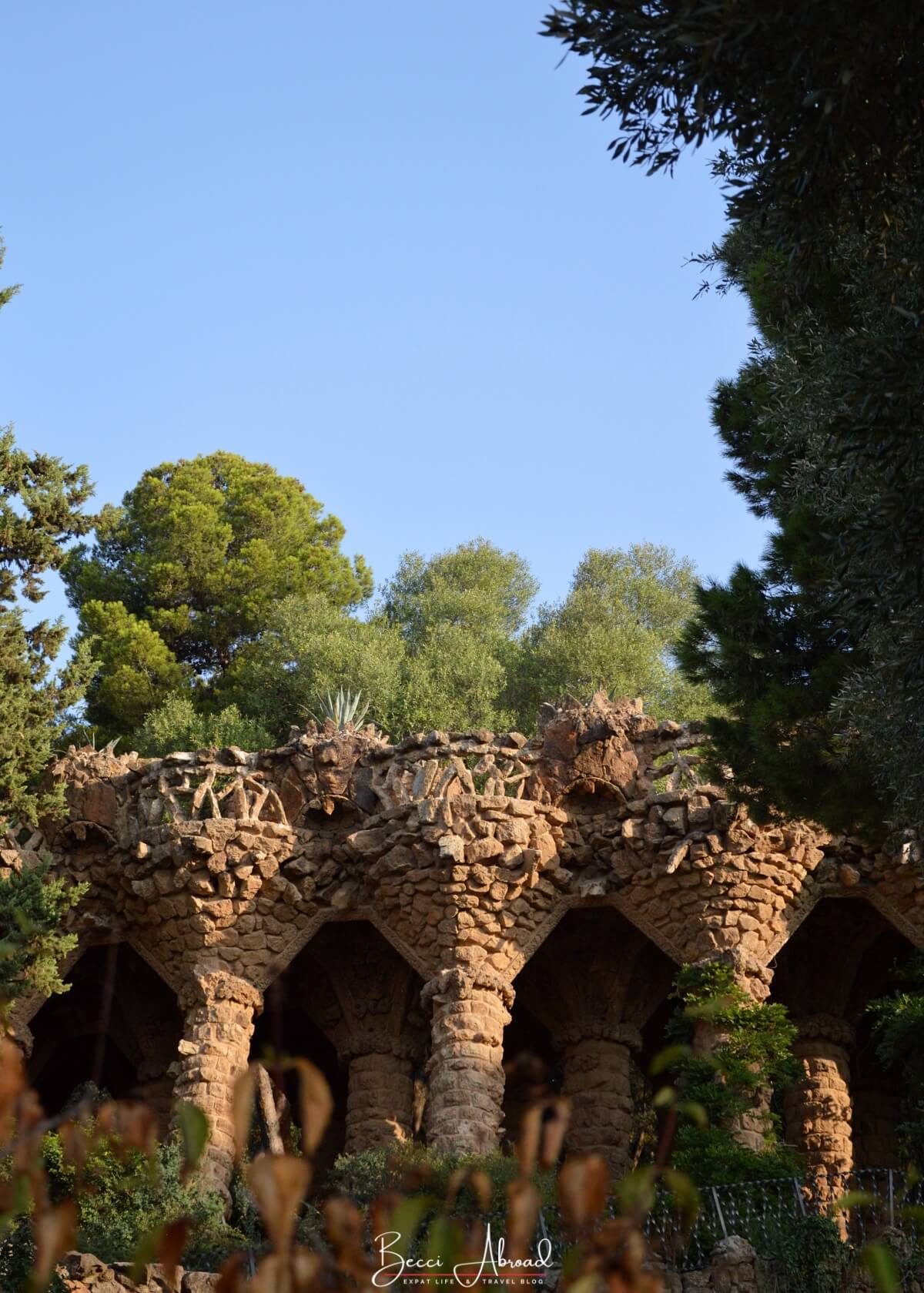

Guided Walking Tour of Park Güell
If you want to dive deeper into the history and significance of Park Güell, I would recommend that you do a guided walking tour of the park.
A guided tour can provide fascinating insights into Gaudí’s architecture, the symbolism behind his designs, and the history of the park.
A guide can also point out lesser-known details and hidden gems that you might miss during a self-guided visit. Because honestly, the level of information on the signs around the park is very limited.
Tours usually last around 1 to 1.5 hours and offer a comprehensive look at the park’s Monumental Zone and its surrounding areas.
Photo Tour of Park Güell
Another popular thing to do in Park Güell is to do a photoshoot in the park.
Explore the park on a small-group or private photo tour with a professional photographer who will capture your visit. The tickets to the park are included in your tour.
A photoshoot is especially great if you are traveling to Barcelona with friends or family, and want to make sure you have some amazing photos of everybody in these unique surroundings.
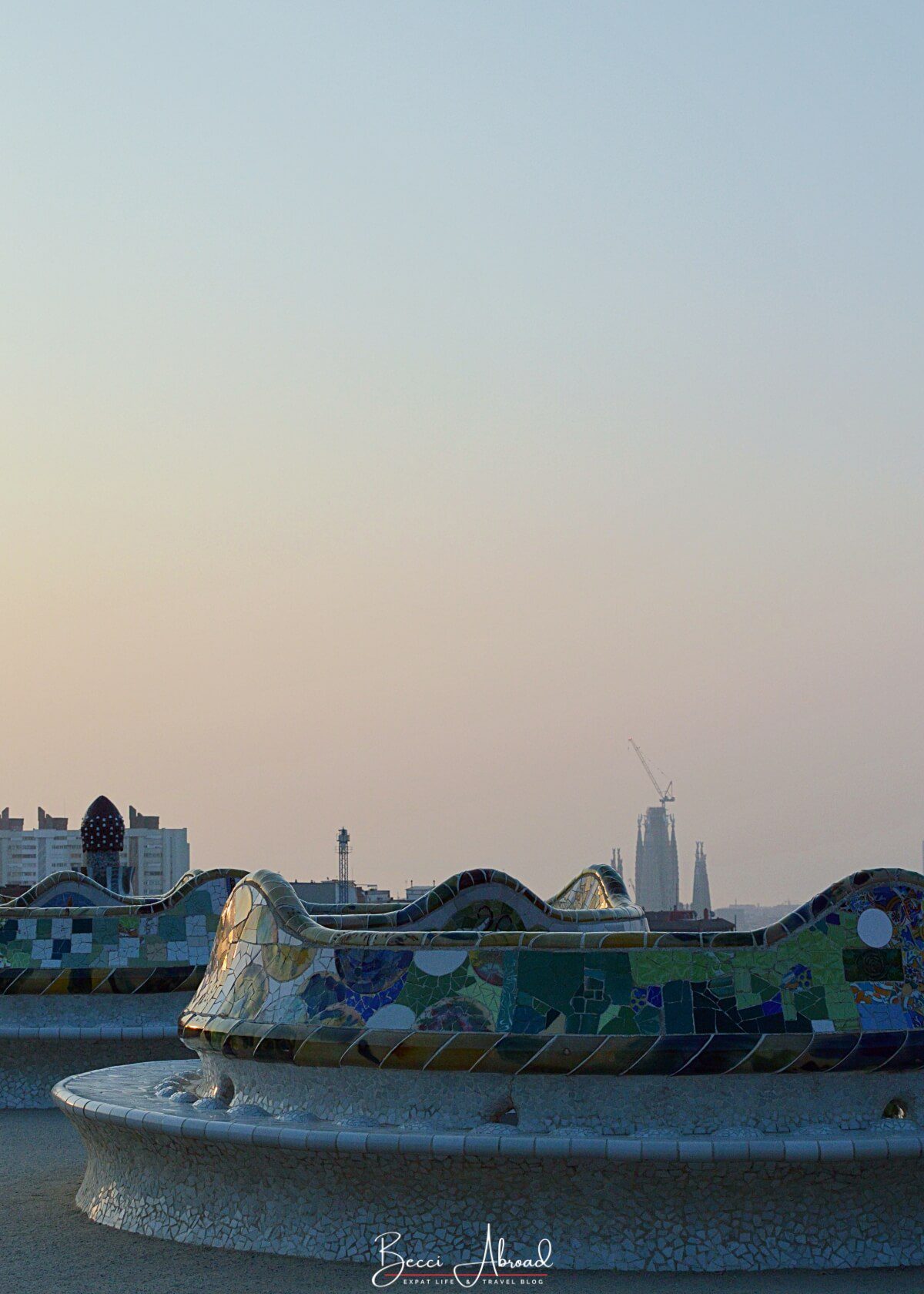

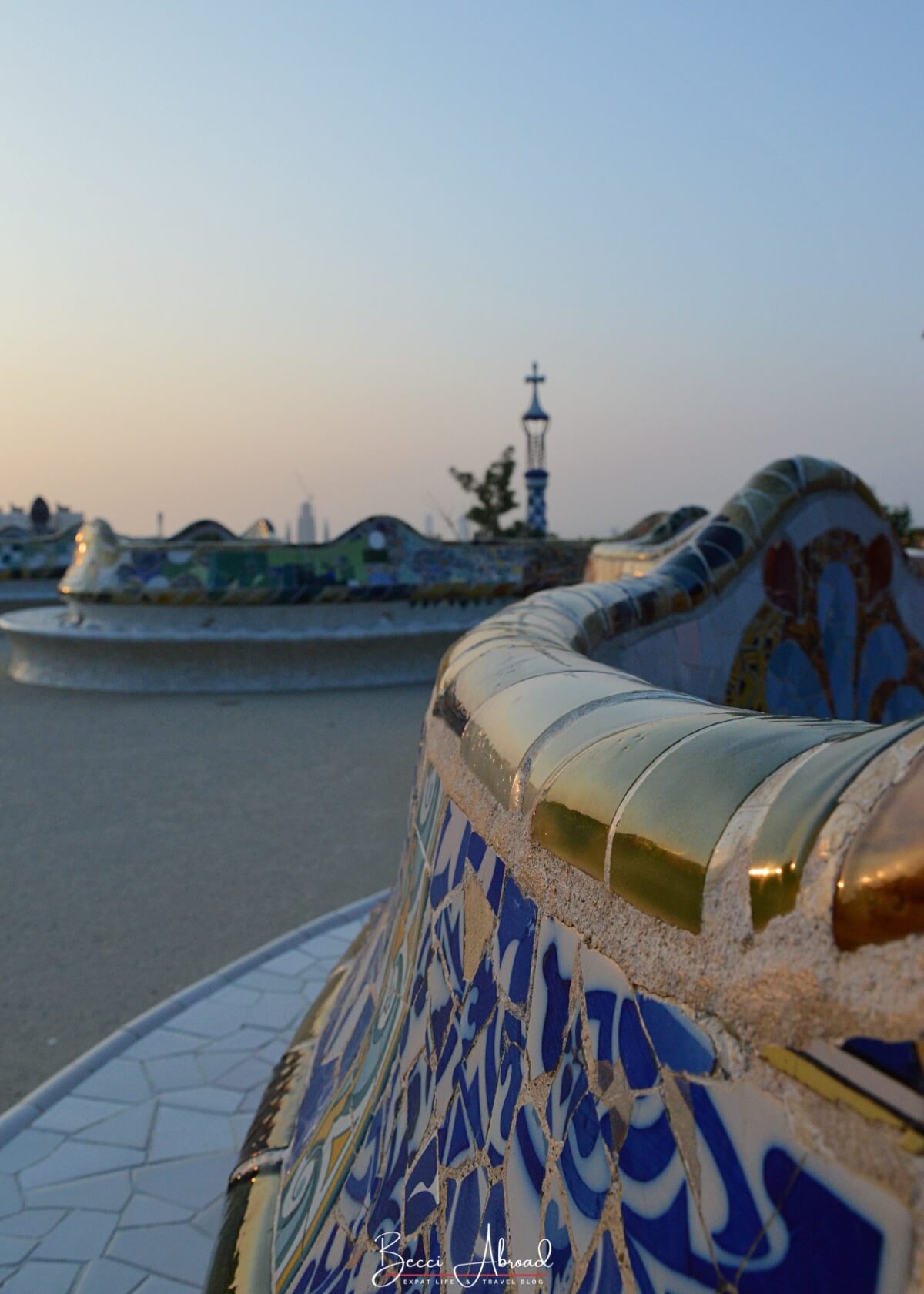
How to Get to Park Güell?
A question that most people ask is how to get to Park Güell. Of course, it depends on where you are staying in Barcelona.
Here are the most common ways to go to Park Güell:
- By metro
- By bus
- By taxi
Let’s look at each of them:
How to Get to Park Güell by Metro?
The closest metro stations from Park Güell are Lesseps and Vallcarca on the green L3 metro line, and a bit less close metro station is El Coll on the blue L5 metro line.
From Lesseps Metro Station on the L3 Line
From the Lesseps metro station on the green L3 metro line, you get to the main entrance in around 15 minutes on foot.
When you get off the train at Lesseps station, take the exit towards Plaça Lesseps. From Plaça Lesseps, walk along the big road Travessera de Dalt until you reach Carrer Larrard.
Walk uphill on Carrer Larrard until the end of the street, and turn right on Carrer d’Olot.
At Carrer d’Olot, you’ll find the main entrance to Park Güell!
In my opinion, this is the easiest way to get to Park Güell. There is a bit of uphill walking towards the end, but it isn’t too bad.
Another option is to turn on Avinguda del Santuari de Sant Josep de la Muntanya, one block before Carrer Larrard when you are walking on Travessera de Dalt.
Follow the street until you reach an outdoor mechanical escalator. Continue straight ahead until you reach the intersection of Avinguda del Santuari de Sant Josep de la Muntanya and Carrer d’Olot. Sometimes, there is a small additional entrance to Park Güell there.
Otherwise, you need to turn right on Carrer D’Olot and walk down a flight of stairs until you reach the park’s main entrances.
Alternatively, you can take a taxi from the Lesseps metro station to the park entrance. The ride shouldn’t take more than 5 minutes.
From Vallcarca Metro Station on the L3 Line
From the Vallcarca metro station on the green L3 metro line, there is a quiet and uphill walk to reach the entrance of Park Güell.
Okay, let’s be completely honest here; there is A LOT of uphill walking on small stairs from Vallcarca metro station!
I wouldn’t recommend you get off at Vallcarca, except if you are in good shape and want some extra fitness. The reason why the walk is so uphill is that the Vallcarca route takes you to the upper entrance of the park.
Get off at the Vallcarca metro station and follow the Park Güell exit signs. The signs will say Parc Güell, not Park Güell.
Once you have exited the metro, turn left at Baixada de la Gloria and climb the steep stairs up. There used to be an escalator going up. But recently, there has been some construction on the street, meaning you could only walk up on some tiny stairs.
The benefit of the route from Vallcarca is that you will enter Park Güell from its highest point and make your way downhill towards to main entrance.
The panoramic views over Barcelona are amazing as you walk down. However, it is a bit of a walk to get down to the main areas of interest. I prefer the route from Lesseps to the main entrance.
From El Carmel Metro Station on the L5 Line
From El Carmel metro station on the blue L5 metro line, it is around 1.6 kilometers and 20-25 minutes walking to the Carmel Entrance of Park Güell.
The blue L5 metro line is a good option if you are coming from or going to Sagrada Familia. But it includes a lot of walking in an area with mostly uphill roads.
From El Coll Metro Station on the L5 Line
Another option on the blue L5 metro line from Sagrada Familia is to take the metro to the metro stop El Coll | La Teixonera. From El Coll metro station, take the exit of Passeig Mare de Déu del Coll.
From the metro station El Coll, it is around 20 minutes walking to the Carmel entrance of Park Güell.
On your walk, you will pass by a nice viewpoint called Mirador de Joan Sales. Needless to say, this walk is also pretty uphill. But if you want to explore a different side of Barcelona and see some great views of the city, this route is an option.

How to Get to Park Güell by Bus?
Some of the public bus lines and the hop-on hop-off tourist bus stop near Park Güell.
Hop-on Hop-off Tourist Bus
The Barcelona Hop-on Hop-off Tourist bus’s blue route stops at Park Güell.
The blue line also goes by the Sagrada Família, so it’s ideal if you want to visit both on the same day.
However, the bus stop is located pretty far from the entrance to the park. You could take this into consideration if you plan on visiting the park as part of a trip on the hop-on hop-off bus in Barcelona.
Local Bus to Park Güell
There are a couple of public bus services that drop you off more or less close to the entrance of the park:
- Bus line 24 (stop Park Güell)
- Bus line 92 (stop Park Güell)
- Bus line 116 (stop Olot/Mariano)
- Bus line 24 (stop CAP Larrard)
- Bus line 32 (stop CAP Larrard)
- Bus line H6 (stop CAP Larrard)
I normally just use Google Maps to determine which one is the bus stop and the bus line that works the best for me.
Sometimes, walking from the metro might be the most straightforward option for getting to the park.
How to Get to Park Güell by Taxi?
Taxis are widely available in Barcelona, and it is a great alternative for getting to Park Güell if you are short on time.
Ask the taxi driver to drop you off at the main entrance at Carrer de Larrard. This is the most convenient entrance as it leads you directly to the most popular part of the park, the Monumental Zone.
During peak hours, a taxi ride may cost. This is another good reason for trying to visit Park Güell either during the early morning or afternoon hours.

How to Get From Park Güell To Other Landmarks in Barcelona
It is easy to combine a visit to Park Güell with visits to other popular landmarks in Barcelona, either by walking, taking public transportation, or by taxi.
Let’s explore some of the most common landmarks to combine with a visit to Park Güell.
How To Get From Park Güell To Sagrada Familia?
You can easily combine a visit to Park Güell with a visit to Sagrada Familia.
I would strongly recommend visiting Park Güell in the morning before going to Sagrada Familia. First of all, because the mornings are less crowded in Park Güell, and in the summer the heat isn’t as strong.
And secondly, if you choose to walk to Sagrada Familia, the walk from Park Güell to Sagrada Familia is downhill. As opposed to uphill when walking from Sagrada Familia to Park Güell.
Walking Distance from Park Güell to Sagrada Familia
The walk from Park Güell to Sagrada Família is about 35-45 minutes, depending on how fast you walk (and how many photo stops you make).
When walking from Park Güell to Sagrada Familia, you will pass through the neighborhood of Grácia, a great place to stop for lunch.
Make sure you leave yourself with enough time between visiting Park Güell and your entrance to Sagrada Familia to have time for the walk and lunch.
Metro from Park Güell to Sagrada Familia
To get from Park Güell to Sagrada Familia by metro, you can take the green L3 metro line from Vallcarca or Lesseps metro station to Diagonal and transfer to the blue L5 metro line to reach Sagrada Família.
You can also walk from Park Güell to the yellow L4 metro station Alfons X, take the metro two stops to Verdaguer, and transfer to the blue L5 metro line to Sagrada Familia.
Bus from Park Güell to Sagrada Familia
To get from Park Güell to Sagrada Familia by bus, the easiest way is to take either bus V19 or bus 114.
With bus from Park Güell to Sagrada Família takes around 30 minutes, including walking to and from the bus stops.
For bus V19, exit Park Güell by the Carrerta del Carmel exit and walk around 160 meters down the road until you find the bus stop for V19 in the direction of Barceloneta. Get off the bus at Passeig de Sant Joan – Rosselló, and walk for around 10 minutes until you reach Sagrada Familia.
For bus 114, exit Park Güell by the Carrerta del Carmel exit. Walk down Avenida de Pompeu Fabra for around 8 minutes (600 meters). Wait for bus 114 by the bus stop Sardenya-Camèlies. Ride the bus for around 12 minutes and get off at the stop Passeig de Sant Joan – Còrsega. From the bus stop, there are 4 blocks to Sagrada Familia.
Taxi from Park Güell to Sagrada Familia
A taxi ride from Park Güell to Sagrada Família takes approximately 10-15 minutes, depending on traffic.
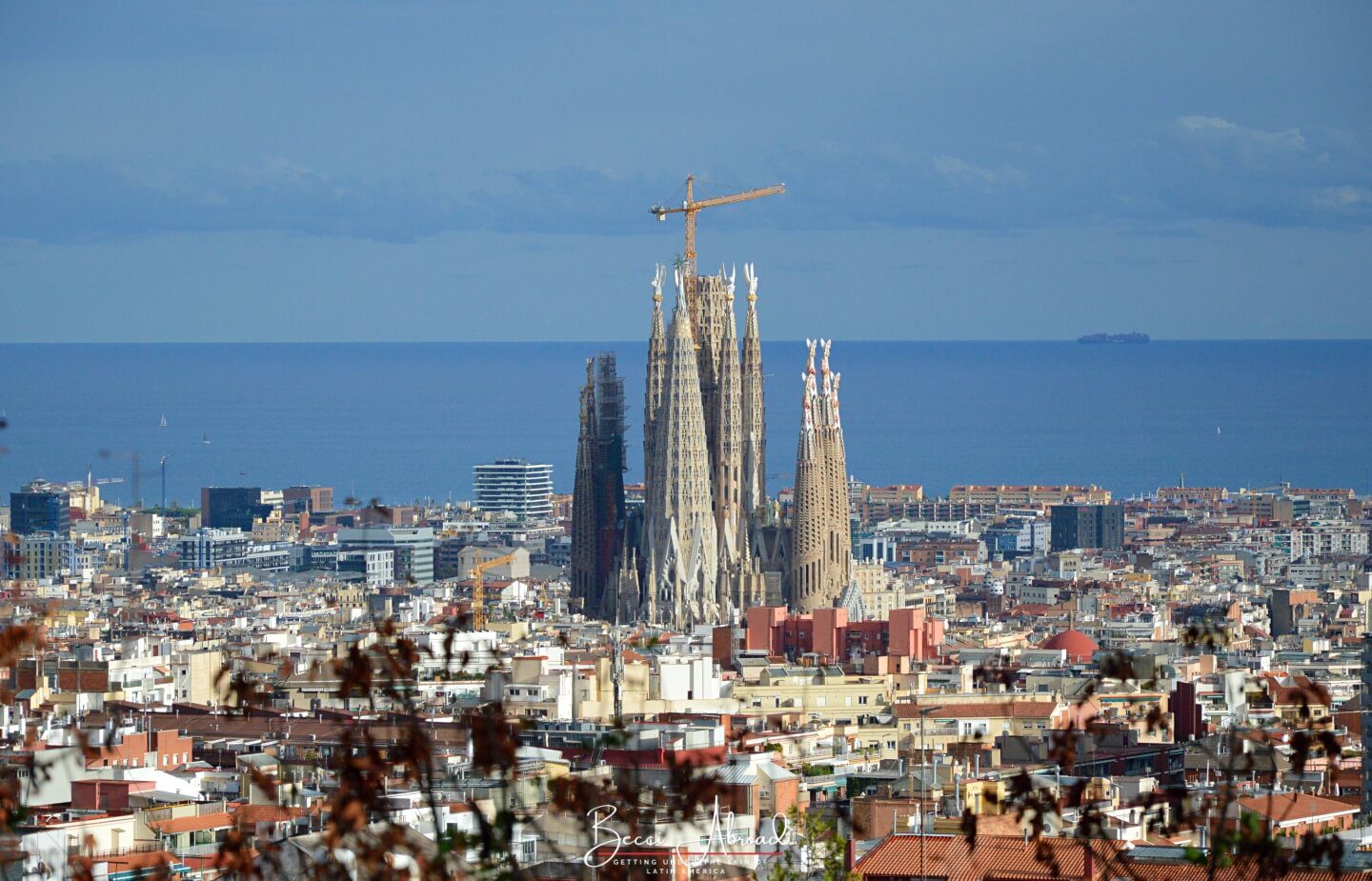
How to Get to Park Güell from Plaza Catalunya?
If your hotel or Airbnb is located in La Rambla or the Gothic Quarter, the best reference point for you to get to and from Park Güell is Plaza Catalunya.
Here are the best ways to get from Park Güell to Plaza Catalunya by walking, catching the metro, or by taxi.
Walking Distance from Park Güell to Plaza Catalunya
Walking from Park Güell to Plaza Catalunya takes around 45 minutes to an hour, depending on how fast you walk and how many stops you make on your way.
The distance is around 3.8 kilometers, and you can pass by important landmarks and attractions such as Passeig de Gracia, Casa Milá, and Casa Battló on your way.
It is easier to walk from Park Güell to Plaza Catalunya than the opposite since from the park you will be walking downhill.
Metro from Park Güell to Plaza Catalunya
Walk from Park Güell and take the green L3 metro line from Vallcarca or Lesseps metro station to Plaza Catalunya. The metro ride takes around 15 minutes.
Bus from Park Güell to Plaza Catalunya
The easiest bus route to take from Park Güell to Plaza Catalunya is bus 24.
Take the Carretera del Carmel exit from Park Güell and walk around 160 meters (one block) down the road to the bus stop for bus 24. The bus ride takes around 27 minutes to Plaza Catalunya.
Taxi from Park Güell to Plaza Catalunya
A taxi ride from Park Güell to Plaza Catalunya will take about 15-20 minutes, depending on traffic.


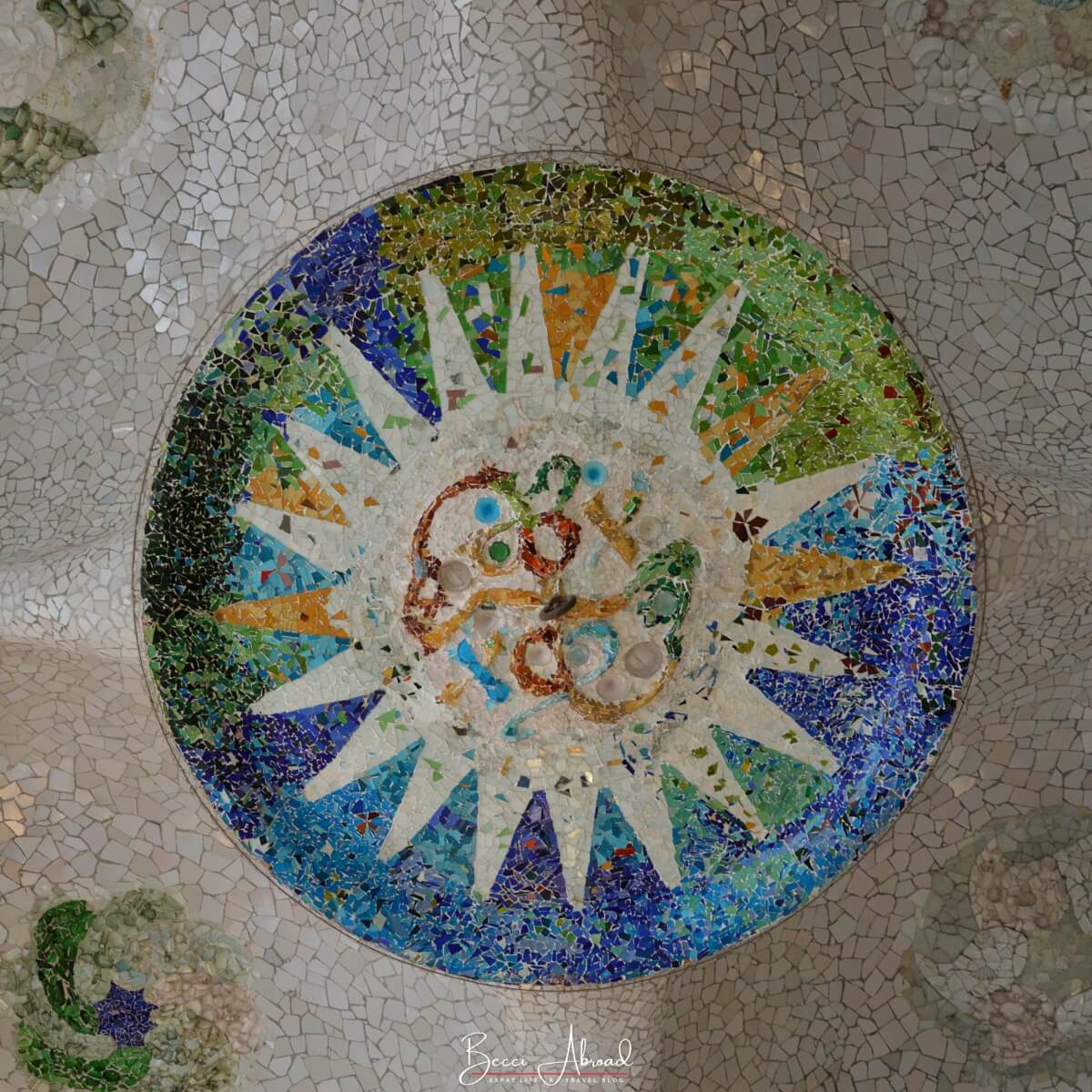
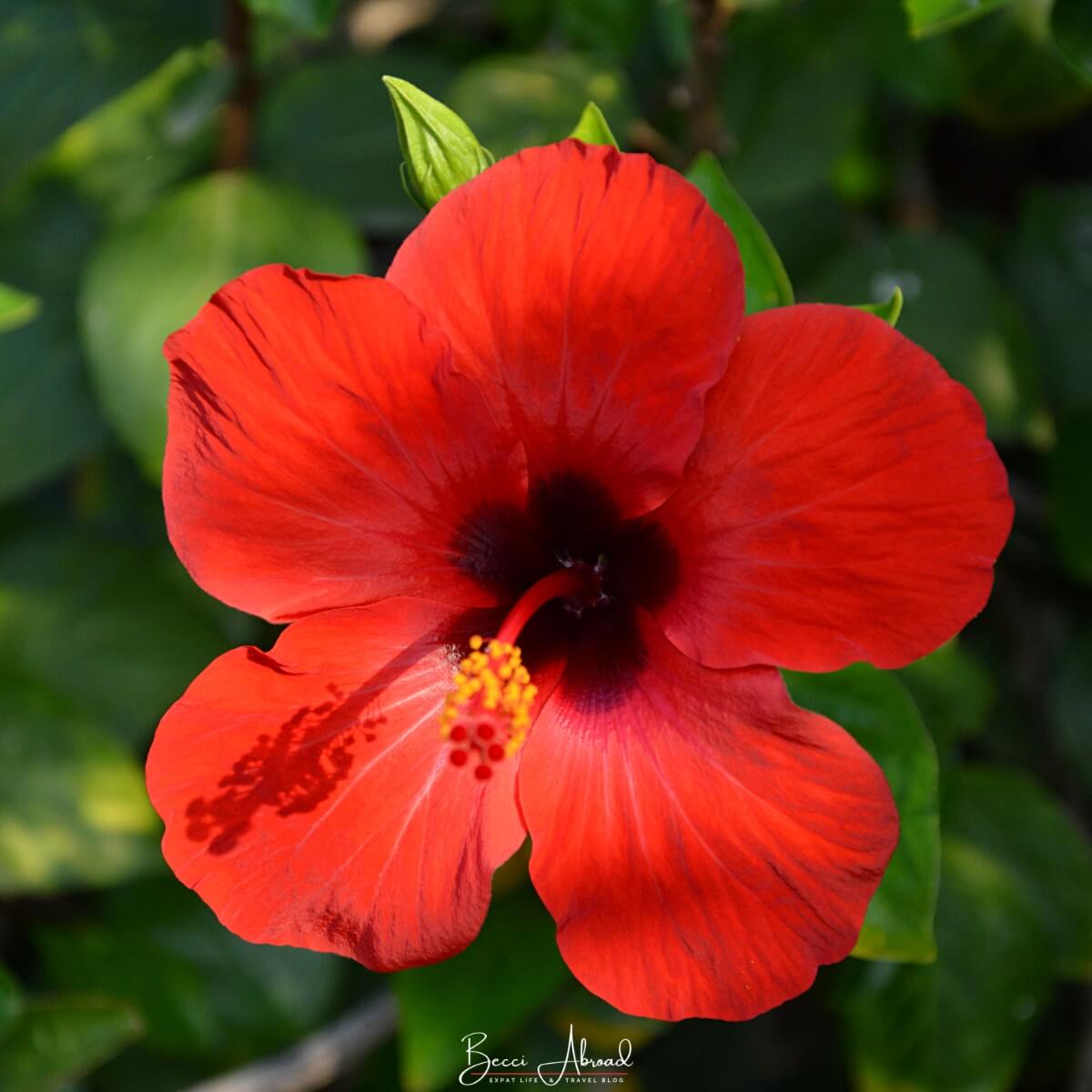
How to Get From Park Güell to Casa Batlló?
Casa Batlló is another popular attraction to visit in Barcelona, and it is easy to visit on the same day as Park Güell.
Check out my complete guide to Casa Batlló for more information on tickets, opening hours, etc.
Walking Distance from Park Güell to Casa Batlló
The walk between Park Güell and Casa Batlló is about 40-45 minutes (3.1 kilometers), depending on how many stops you make on your way.
Metro from Park Güell to Casa Batlló
The absolute easiest way to get from Park Güell to Casa Batlló is to take the green L3 metro line to Passeig de Gràcia.
From Park Güell, walk to either the metro station Vallcarca or Lesseps and take the metro to the Passeig de Gràcia metro station. Casa Batlló is located right next to the Passeig de Gràcia metro station.
Bus from Park Güell to Casa Batlló
The easiest bus route to take from Park Güell to Casa Battló is bus 24 (the same bus as you would take to Plaza Catalunya).
Take the Carretera del Carmel exit from Park Güell and walk around 160 meters (one block) down the road to the bus stop for bus 24. Get off at the stop Passeig de Gràcia – Consell de Cent.
The bus ride from Park Güell to Casa Battló takes around 20 minutes.
Taxi from Park Güell to Casa Batlló
A taxi ride from Park Güell to Casa Batlló takes approximately 15 minutes.
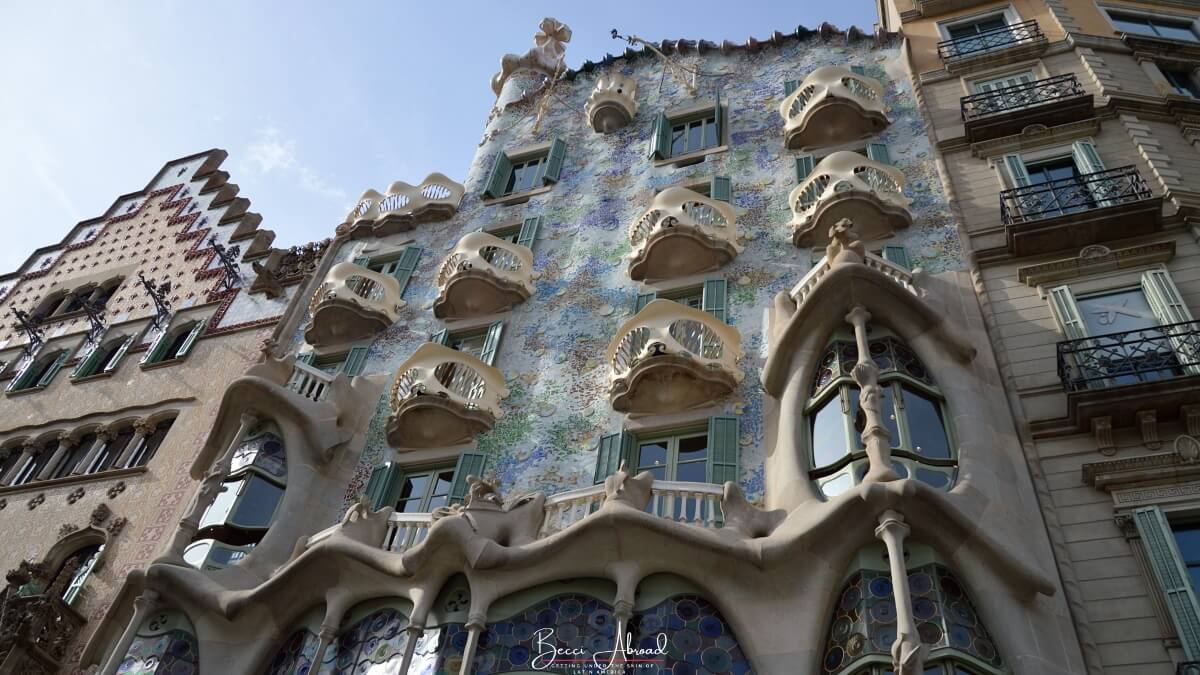
What to Do Near Park Güell?
When visiting Park Güell, don’t miss out on combining your visit with any of these popular nearby things to do in Barcelona:
Visit Gaudí’s First House, Casa Vicens
Casa Vicens is one of Antoni Gaudí’s first architectural works, showcasing his early exploration of vibrant colors, intricate tilework, and bold design.
Casa Vicens is located close to Park Güell in the Gràcia neighborhood and is a must-see for architecture lovers.
Enjoy the Views from Bunker del Carmel
For some of the best views of Barcelona, head to Bunker del Carmel, a short (uphill) walk from Park Güell.
Originally, the bunkers were used as anti-aircraft defenses during the Spanish Civil War. Today, it has become a popular spot for both locals and tourists to enjoy the impressive views over Barcelona.
Explore the Gracia Neighbourhood
Gràcia is a vibrant area with narrow streets, local shops, and charming plazas, perfect for a leisurely afternoon stroll after visiting Park Güell.
La Sagrada Familia
La Sagrada Familia is an absolute must-visit attraction in Barcelona, especially if you are traveling to Barcelona for the first time!
You can easily visit Sagrada Familia and Park Güell on the same day!
When planning your trip, ensure you have enough time to visit these impressive landmarks!
San Pau Modernist Complex
The Sant Pau Modernist Complex is a lesser-known architectural hidden gem in Barcelona, worth visiting if you enjoy architecture!
The site was originally built as a hospital, but now it is a UNESCO World Heritage site known for its vibrant mosaics, intricate façades, and beautiful gardens.
The Sant Pau Modernist Complex is located a short walk from Sagrada Familia, making it a perfect place to visit if you want to experience more spectacular Catalan architecture!

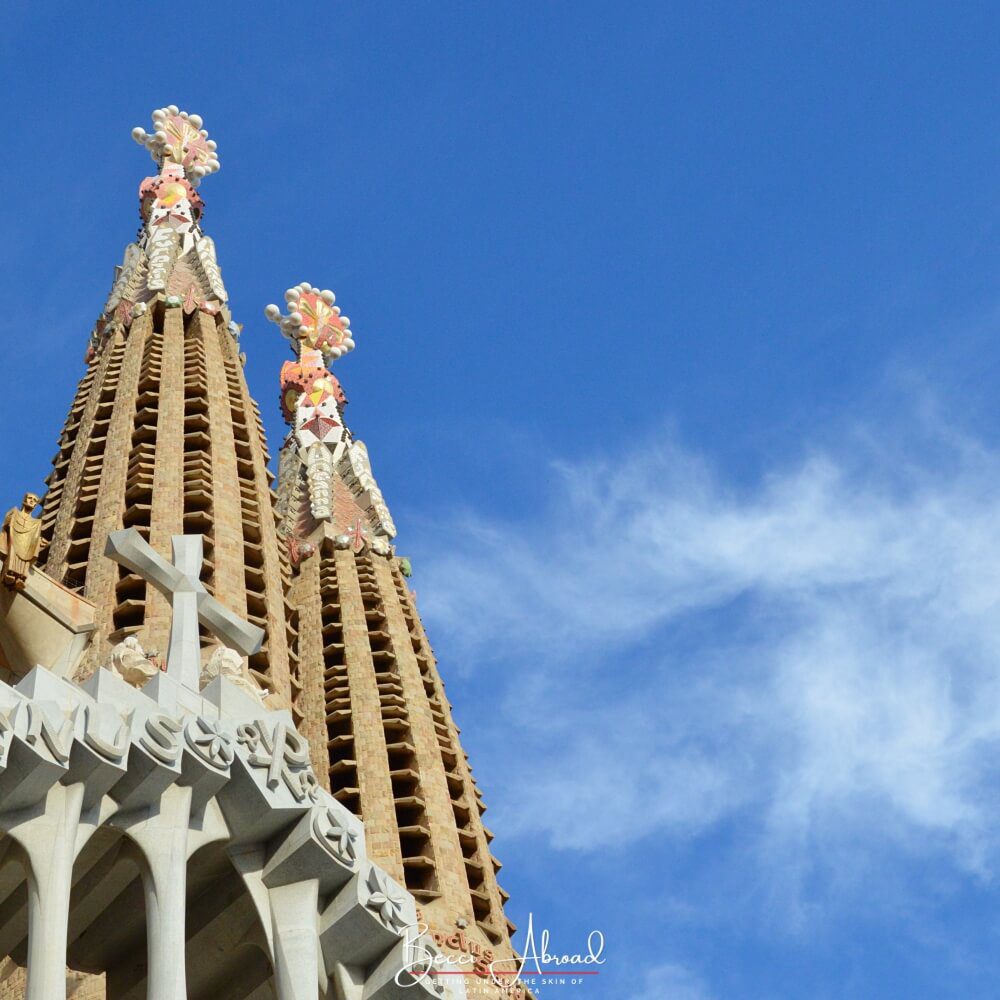

Final Thoughts: Is Park Güell Worth Visiting?
In my opinion, Park Güell is absolutely worth a visit! The park offers a unique combination of art, architecture, and nature.
Park Güell is one of the most iconic landmarks in Barcelona that you will see on almost all promotions for Barcelona, so it is incredible to experience it firsthand.
Apart from that, Park Güell offers some amazing views over Barcelona, which is worth checking out!
However, some people mentioned that they felt underwhelmed by visiting Park Güell. The uphill location and the many paths and stairs around the park seem to catch people by surprise.
Also, the area with the most famous landmarks, the Monumental Zone, is relatively small compared to the size of the whole park.
Good luck with your trip to Park Güell!
